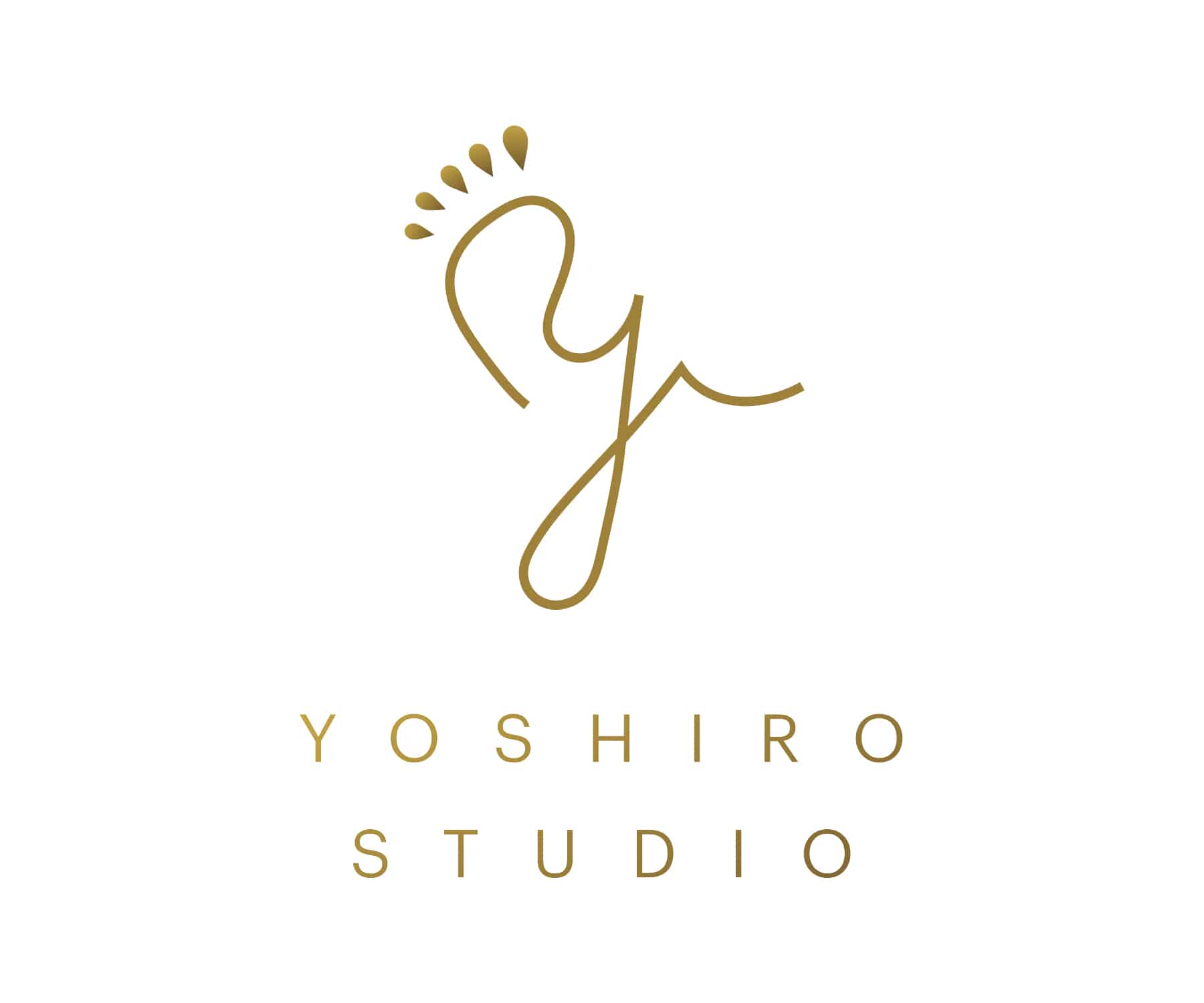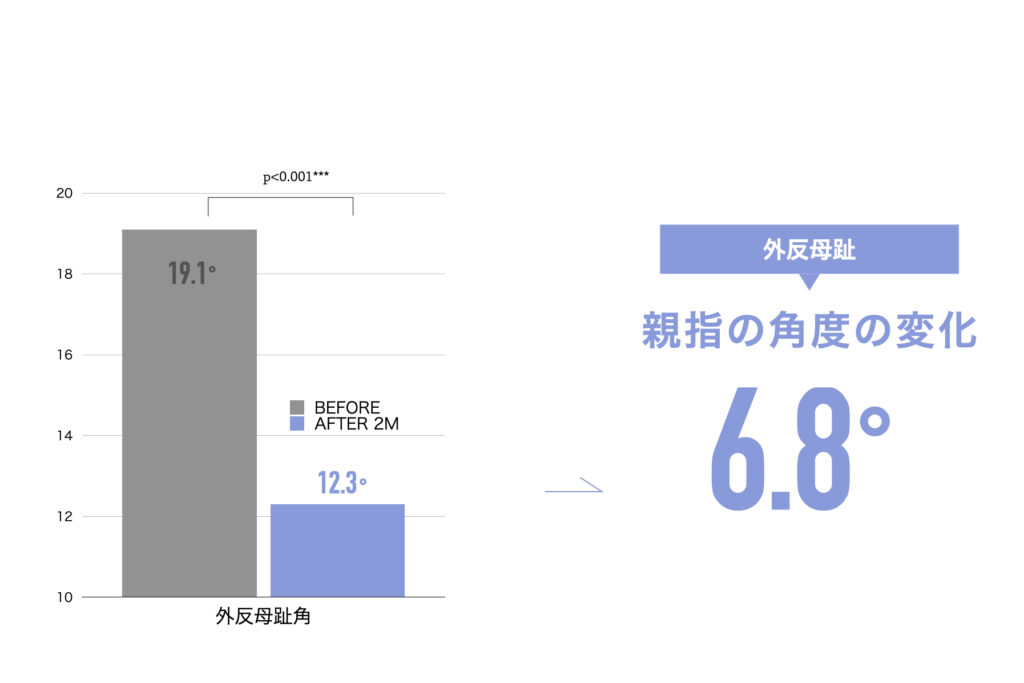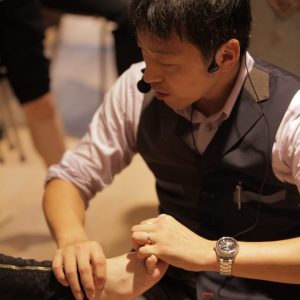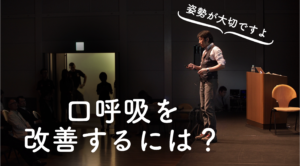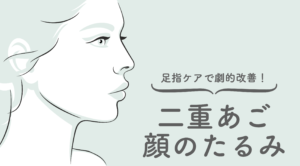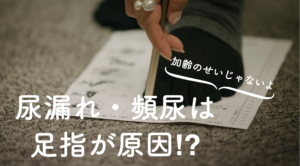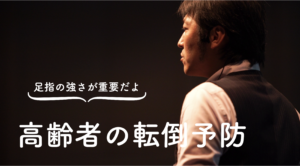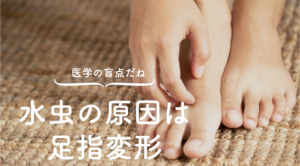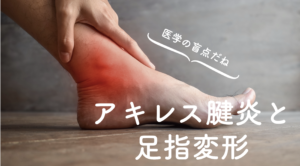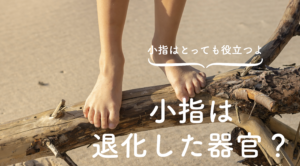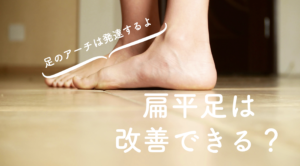About the big toe
The bunion can be easily cured!
The treatment of hallux valgus at YOSHIRO STUDIO is painless and does not restrict daily life. What we do to heal is simple. In the case of pain, we will perform the treatment in combination with AKA therapy so that the pain can be removed as soon as possible, but many people are cured without a visit to the hospital. The photos below are just a few of the cases, but you can see that the deformity of the bone itself has improved even on the x-rays.
Case 1

Case 2

Case 3

Case 4

Case 5

What is Hallux Valgus?
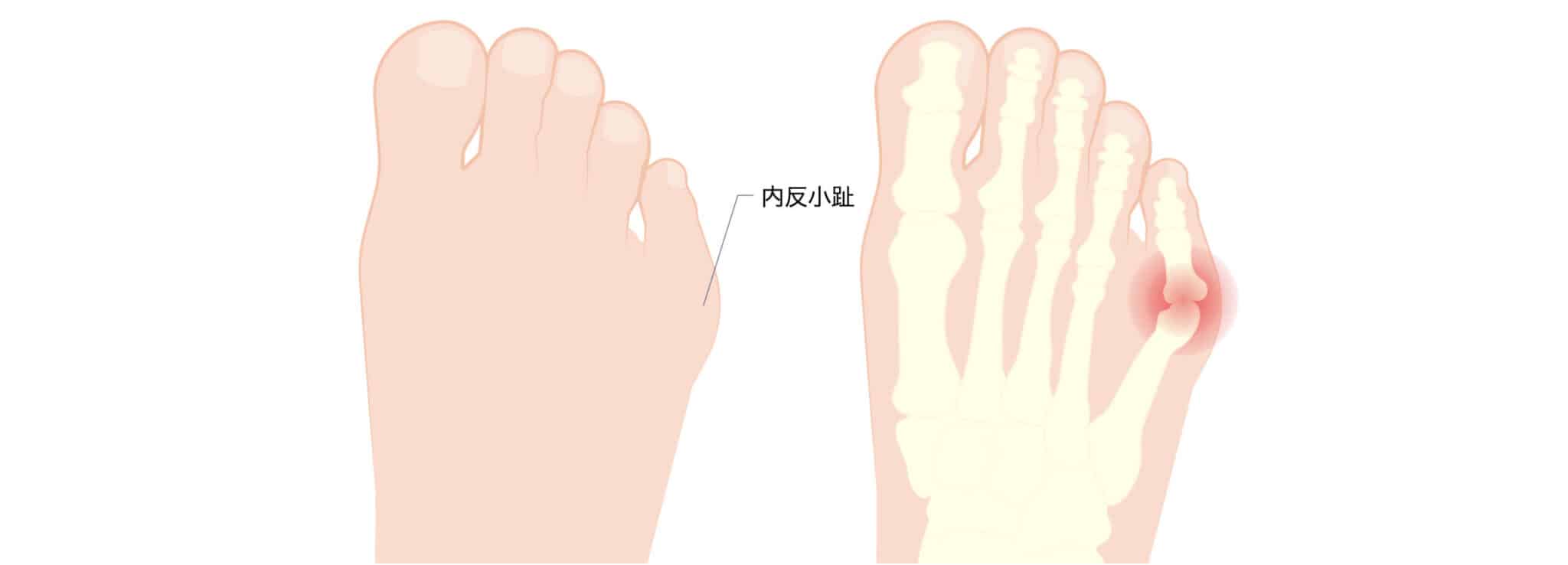
Hallux valgus is a deformity of the little toe that results from a bony lump (which may contain soft tissue) that forms along the side of the fifth metatarsal (little toe). Hallux valgus usually occurs on the thumb side of the foot, while a bony prominence on the side of the little toe is called a hallux valgus. Hallux valgus is not as common as hallux valgus, but the symptoms and causes are similar.
Hallux valgus causes pain in the outer part of the foot. Pain and discomfort usually occur when wearing shoes that rub against the area. Rubbing can damage the skin and cause infection. It is very similar to the big toe in those areas, and it is important to remember that anyone can develop hallux valgus at any point in their life.
With severe hallux valgus, wearing wide shoes is often painful. If you see an orthopedic surgeon at a hospital or clinic, surgery may be recommended if you are unable to wear shoes. The idea is to remove the bony prominence and correct alignment to alleviate pain. Minimally invasive bunion surgery attempts to remove the painful bunion and allow the patient to return to daily activities as soon as possible. In most cases, full recovery takes only a few weeks, while recovery from traditional surgery can last six months or longer.
Hospital and orthopedic treatments

Before surgery, your doctor may recommend that you try the following
Wear wider shoes with more room in the toes.
Anti-inflammatory drugs to reduce swelling and relieve symptoms
. Pads on the sides of the feet to prevent friction
Stretch calves several times a day to loosen stiff muscles.
There are several types of hallux valgus and surgery may be recommended, including
Mild hallux valgus: The surgeon may remove the enlarged bony portion of the foot. They also realign the muscles, ligaments, and tendons of the foot where the big toe has been displaced. This fixes the joint between the toes, but may result in loss of function of the little toe.
Moderate hallux valgusIf the bone is misaligned, the surgeon will cut the bone and then move it back into place along with the ligaments, tendons, and muscles.
Severe hallux valgus: The bony growth is removed, but the surgeon may need to amputate the remaining healthy bone to return it to its correct position. The bone will return to its original position along with ligaments, muscles, and tendons, but function of the little finger may be lost.
arthritic hallux valgus: In some cases, the hallux valgus may be caused by other factors, such as arthritis. If arthritis causes inflammation and damage to the joint, the bone may be fused, but the little toe will lose function.
Risks of surgeryAbout
If hospital treatments do not help and your symptoms affect your quality of life, your doctor may recommend surgery. As with all surgeries, you face the risk of complications, including
Joints stiffen.: It may take some time for the toes to return to normal.
Numbness of the little fingerIn some cases, the nerves may be compressed during the procedure, resulting in loss of sensation in the area.
Swelling of little finger: It is normal to have swelling after surgery, but the swelling may not improve.
Delayed healing: After surgery, straining the leg may delay healing.
infectious disease: Open wounds have the potential for infection, redness, swelling, inflammation, and worsening of pain.
Other complications include
Recurrence of hallux valgus
Nerve damage due to surgery
Overcorrection of alignment
However, treating hallux valgus without surgery is sufficient to reduce pain and maintain proper foot function. This will be discussed later.
Signs and Symptoms of Hallux Valgus
Symptoms of hallux valgus depend on the severity of the condition. Usually, hallux valgus begins with a prominent bump or ridge on the outside of the foot. Other symptoms of hallux valgus include
Burning or tingling pain in joints caused by inflammation or swelling
Aggravated by wearing tight shoes, high heels, or shoes that do not fit the foot.
Pain usually improves when shoes are removed
Calluses caused by the rubbing of shoes on protruding ridges
Signs of hallux valgus include
Bone lump on the outer side of the foot at the little toe joint
Bias toward the fourth toe of the little toe of the foot
...Pain in toes and swelling around bone lumps
Inflamed, swollen, or hardened skin over a bony lump
Hard to find shoes that fit comfortably.
Diagnostic Criteria for Hallux Valgus
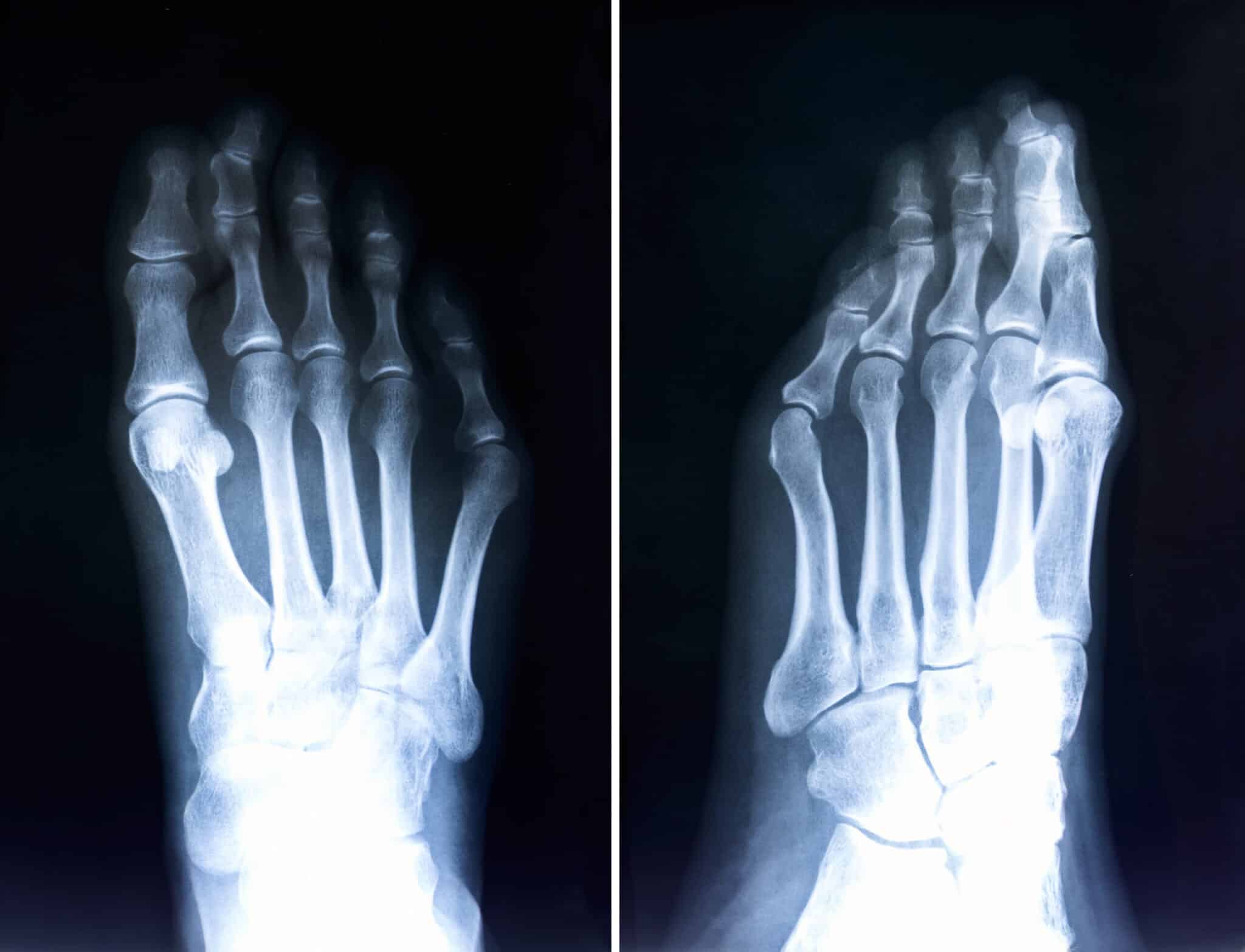
Examination of the foot and, rarely, X-rays are used to diagnose hallux valgus; X-rays can show the extent and morphology of the deformed bones causing the hallux valgus. A simple x-ray taken in a standing position shows the alignment of the bones causing the deformity. The deformity is usually at the fifth metatarsophalangeal joint, which corresponds to the base of the fifth toe. The problem is that the metatarsals (long bones in the middle of the foot) are tilted outward and the toes are tilted inward.
Self-check of hallux valgus

(1) Prepare a ballpoint pen and sit with your feet slightly apart.
(2) Place the ballpoint pen against the outside of the foot, leaving a gap between the ballpoint pen and the little toenail.
(3) If one's index finger is placed in the space between the little finger and the nail, it is an inner ringed pinky finger.
What are the causes of hallux valgus?
Common causes of hallux valgus
The exact cause is unknown to general medicine, and it is believed that genetic factors (family history) and the shape of the foot bones play a major role in the cause. In many cases, shoes are a factor. Certain footwear, such as high heels and pointed-toe shoes, can also cause hallux valgus because they put constant pressure on the toes. Symptoms of hallux valgus are usually exacerbated by wearing shoes that are too narrow. This constant friction and pressure can cause inflammation in the affected area. While it is true that shoes that are too tight can put pressure on the joint, bursa, and surrounding nerves and cause pain, the real cause lies elsewhere. Factors that can contribute to hallux valgus include
Previous injury/trauma to toe joints
Excess mobility/flexible joints
Inflammatory arthritic conditions (rheumatoid arthritis, psoriatic arthritis, etc.)
Tension in the muscles behind the legs
Neuromuscular diseases (stroke, cerebral palsy, multiple sclerosis, Charcot-Marie-Tooth syndrome)
Causes of true hallux valgus
So what are the real causes of hallux valgus? Before we look at the causes of hallux valgus, let us first review the causes of hallux valgus. The cause of hallux valgus is the loss of muscle strength in the foot due to "floating toes" or "bent toes" caused by the lack of proper shoe selection and footwear, which leads to the collapse of the "lateral arch" under the weight of the foot, resulting in an open toe. The width of the foot is widened by this condition, causing the adductor pollicis brevis muscle, which is located from the base of the little toe to the base of the thumb, to stretch. The stretched muscle tries to bend the thumb toward the little toe as the muscle tries to return to its original position. This was the cause of the big toe. See the link below for more information.

On the other hand, the cause of hallux valgus is a loss of muscle strength in the foot due to "floating toes" or "bent toes" caused by a lack of proper shoe selection or footwear, which leads to a collapse of the "lateral arch" under the weight of the foot, resulting in an open foot. This is the same as the big toe. In a hallux valgus foot, the width of the foot widens, causing the adductor pollicis muscle, which is located from the base of the thumb to the base of the little toe, to be stretched. The stretched muscles try to bend the little finger toward the thumb as it tries to return to its original position. This is the cause of hallux valgus. The difference between hallux valgus and hallux valgus is the position of the stretched muscles when the foot becomes open due to muscle weakness.
STEP 1. Muscle weakness in the legs leads to open feet.
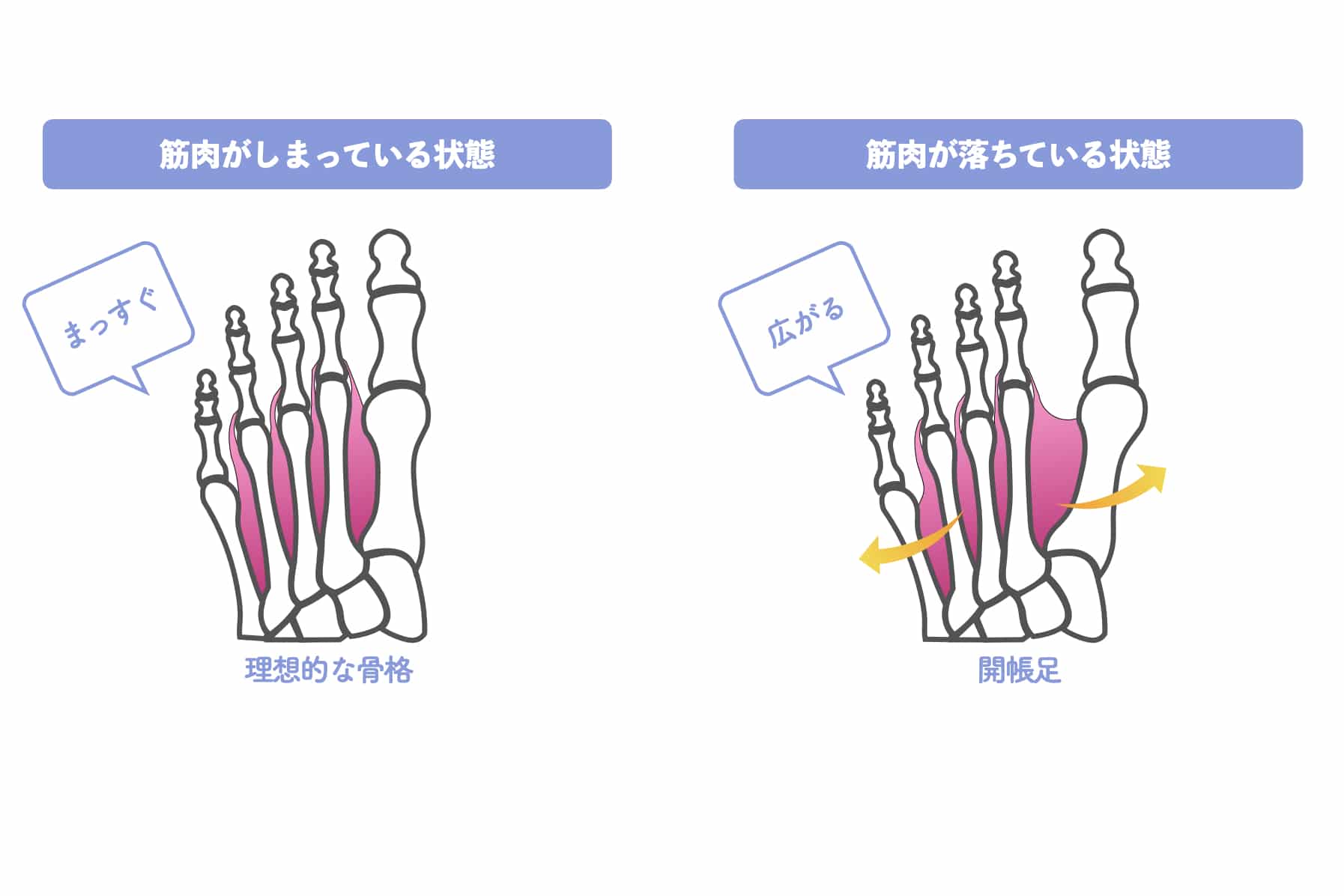
STEP 2. The adductor pollicis brevis muscle is stretched.
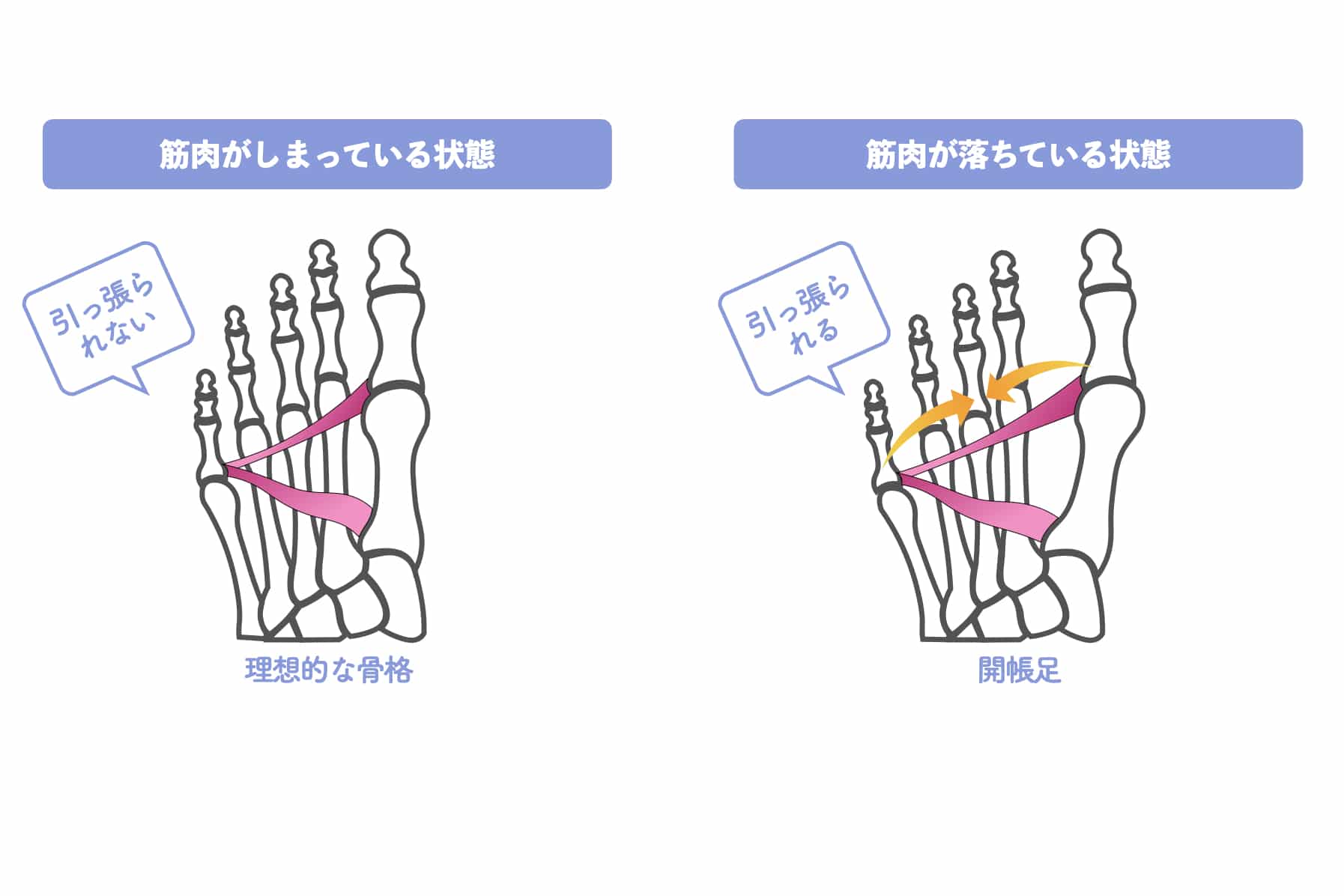
STEP 3: The stretched muscle tries to return to its original position, so the little finger bends.
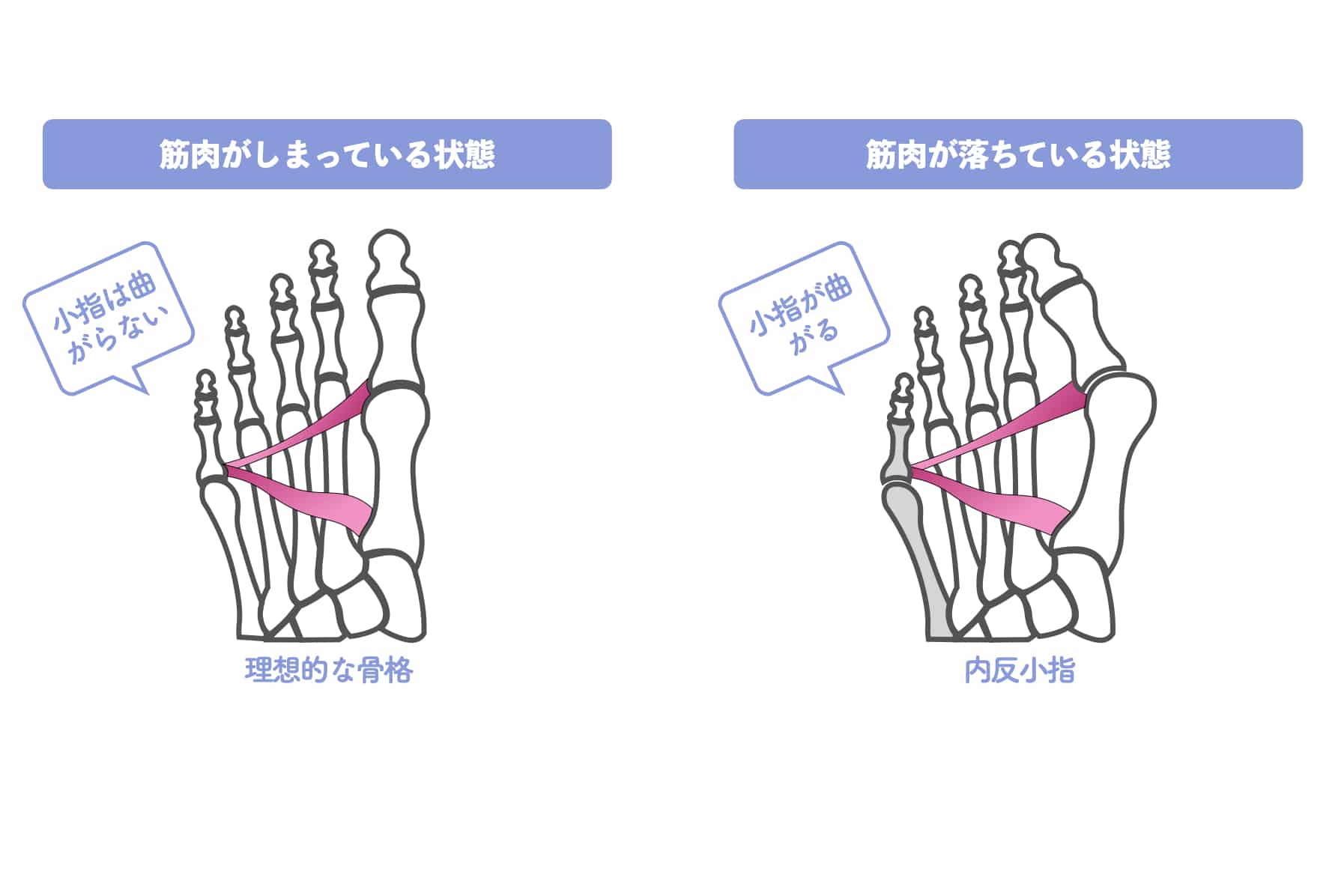
What toe deformities aggravate hallux valgus?
Have you found out that the cause of the clubbed little toe is caused by a loss of strength in the foot muscles due to "floating toes" or "bent toes"? Now, actually check whether you have "floating toes" or "bent toes". If even one of these applies to you, you need to be careful.
floating thumb
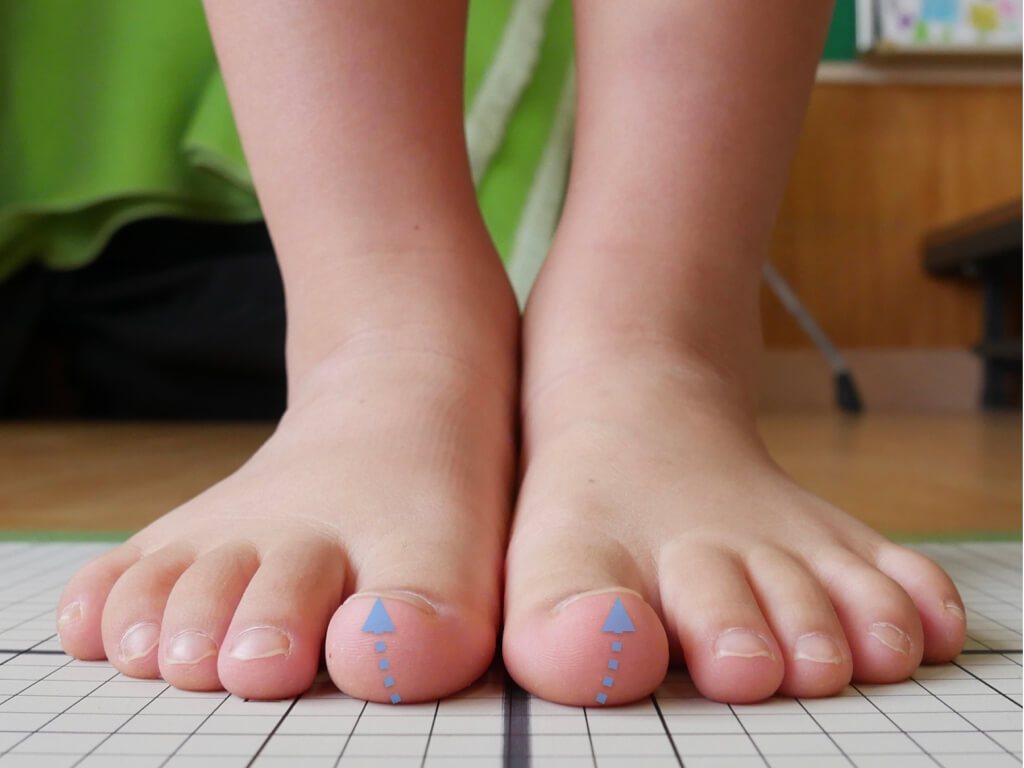
Take a picture of your foot with your phone from directly in front of you. If the thumb nail is difficult to see, you have a "floating toe".
floating pinky toe
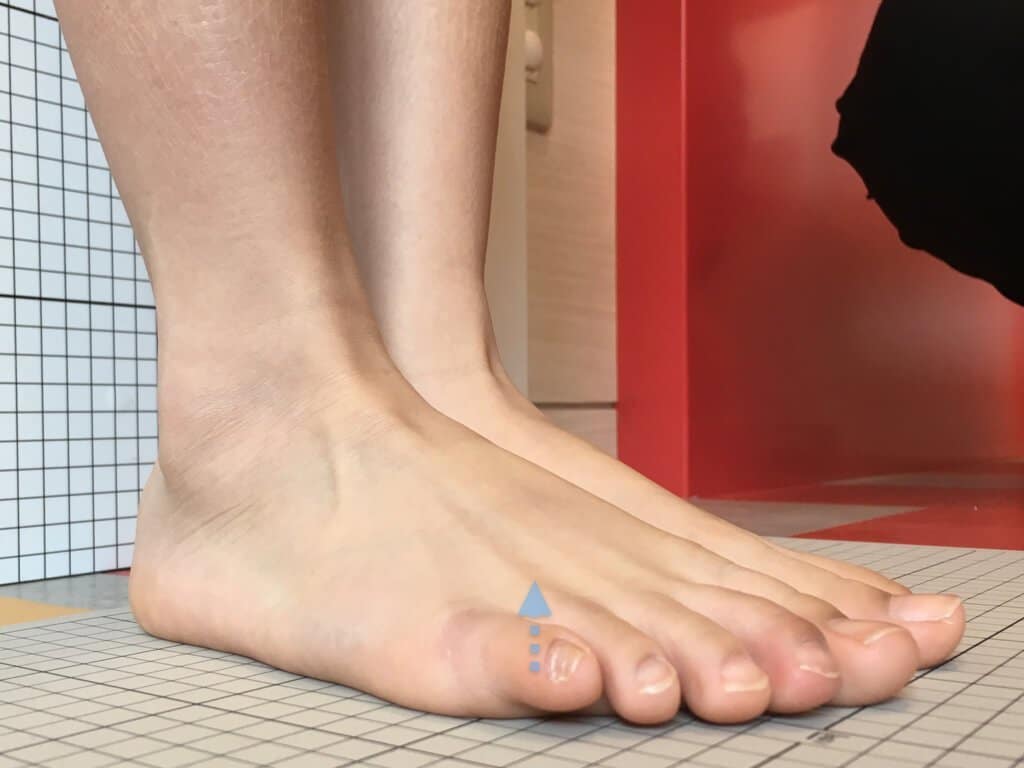
Take a picture of your foot from the side with your phone. If your toes are off the ground, you have "floating toes".
mirror finger
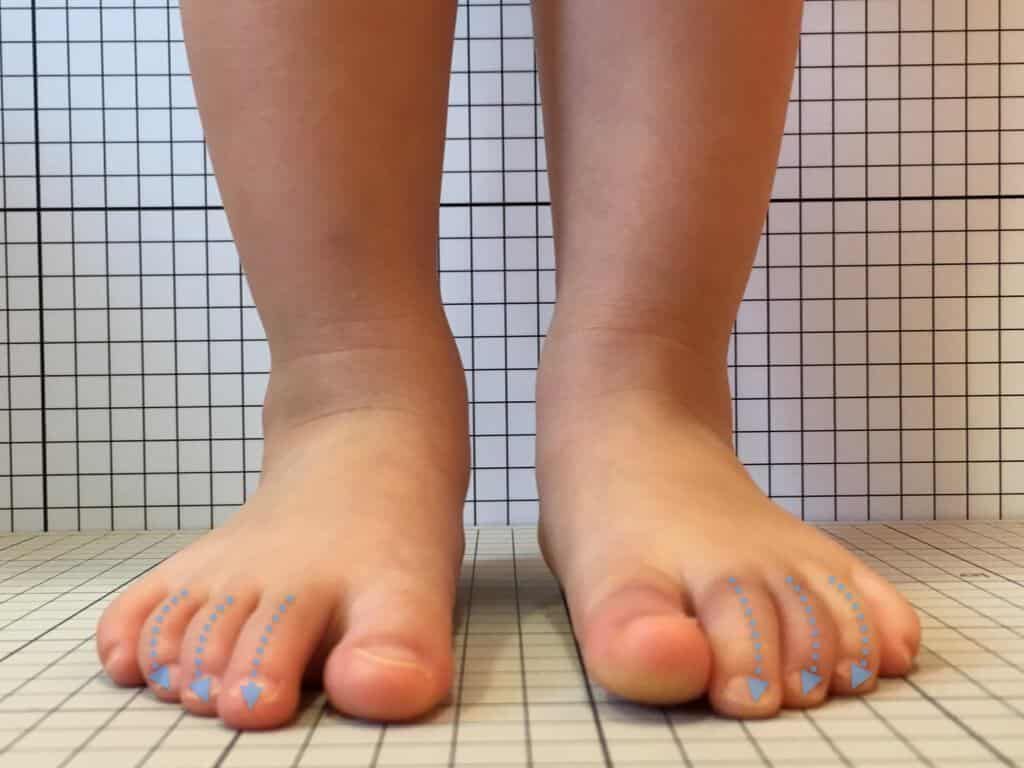
If you look at the foot from the front and the nail is facing downward, it is a "clawed finger".
ring finger
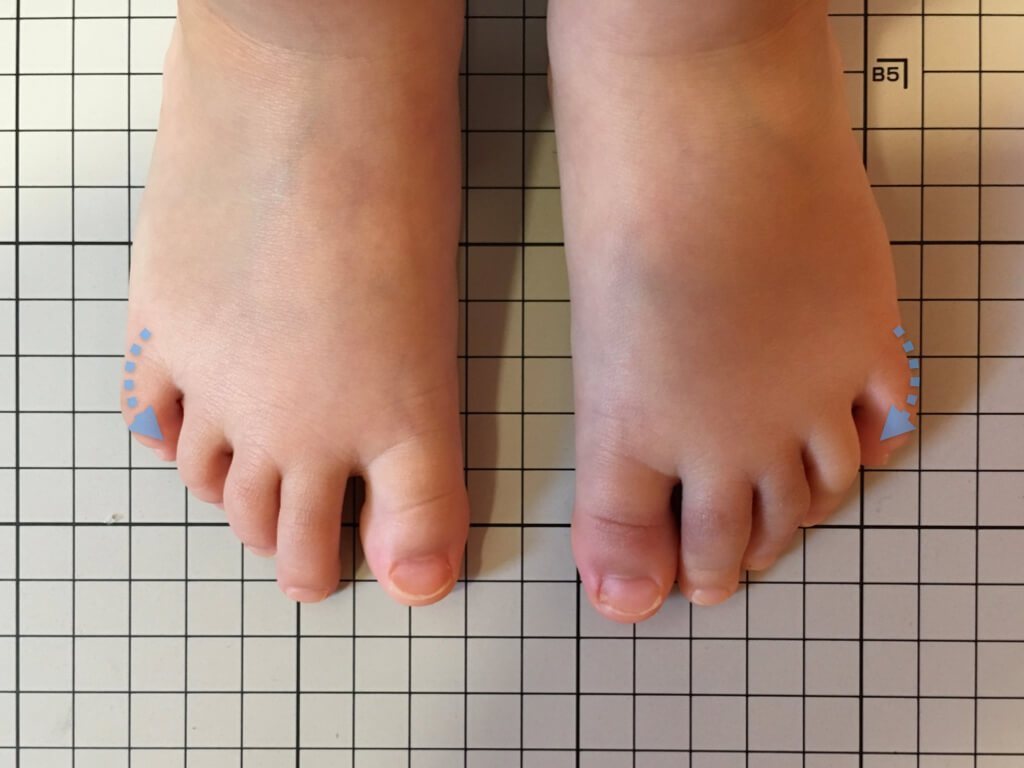
If the little finger or ring finger is lying on its side or bent in the shape of a "ku", it is a "sleeping finger".
What is toe dysfunction that aggravates hallux valgus?
Hallux valgus can also be caused by dysfunction of the toes. When we walk, we push the ground with our toes to obtain the propulsive force to move forward. The action of pushing the ground is the same as "gouging" (grasping), which is analogous to the action of the hand, and thus exercises the muscular strength of the toes. However, when the toes become dysfunctional (functionally inactive), they are not able to push the ground sufficiently when walking, resulting in a gradual loss of sole muscle strength.
Check for toe dysfunction leading to hallux valgus.
Now, let's check whether you can actually use your pinky finger.
Can you par your toes?
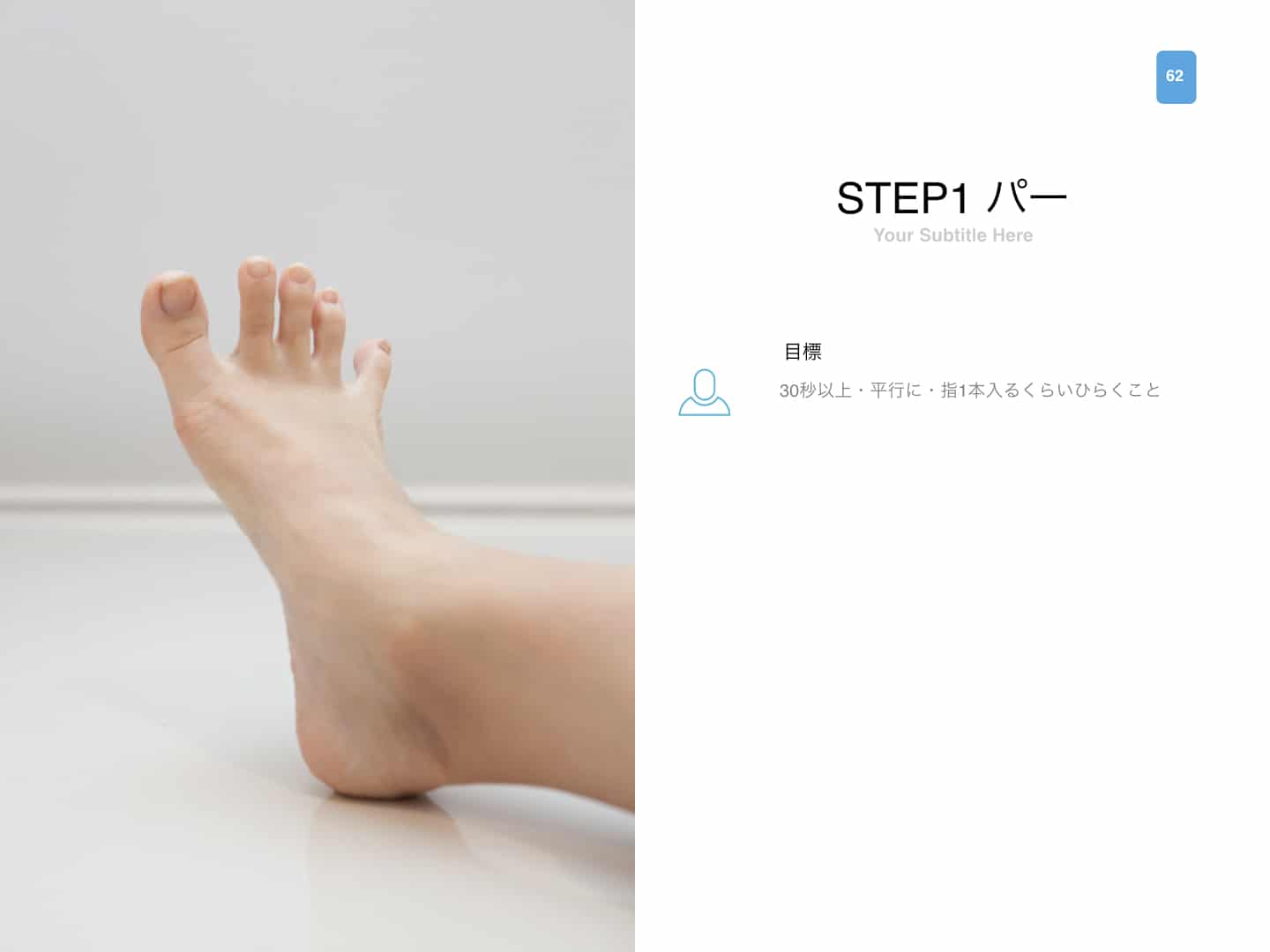
Try paring your toes. Can the little finger of your hand slip between the open ring and pinky toes? If they are aligned and held in that position for at least 30 seconds, there is no problem.
Can you do the toe goo?
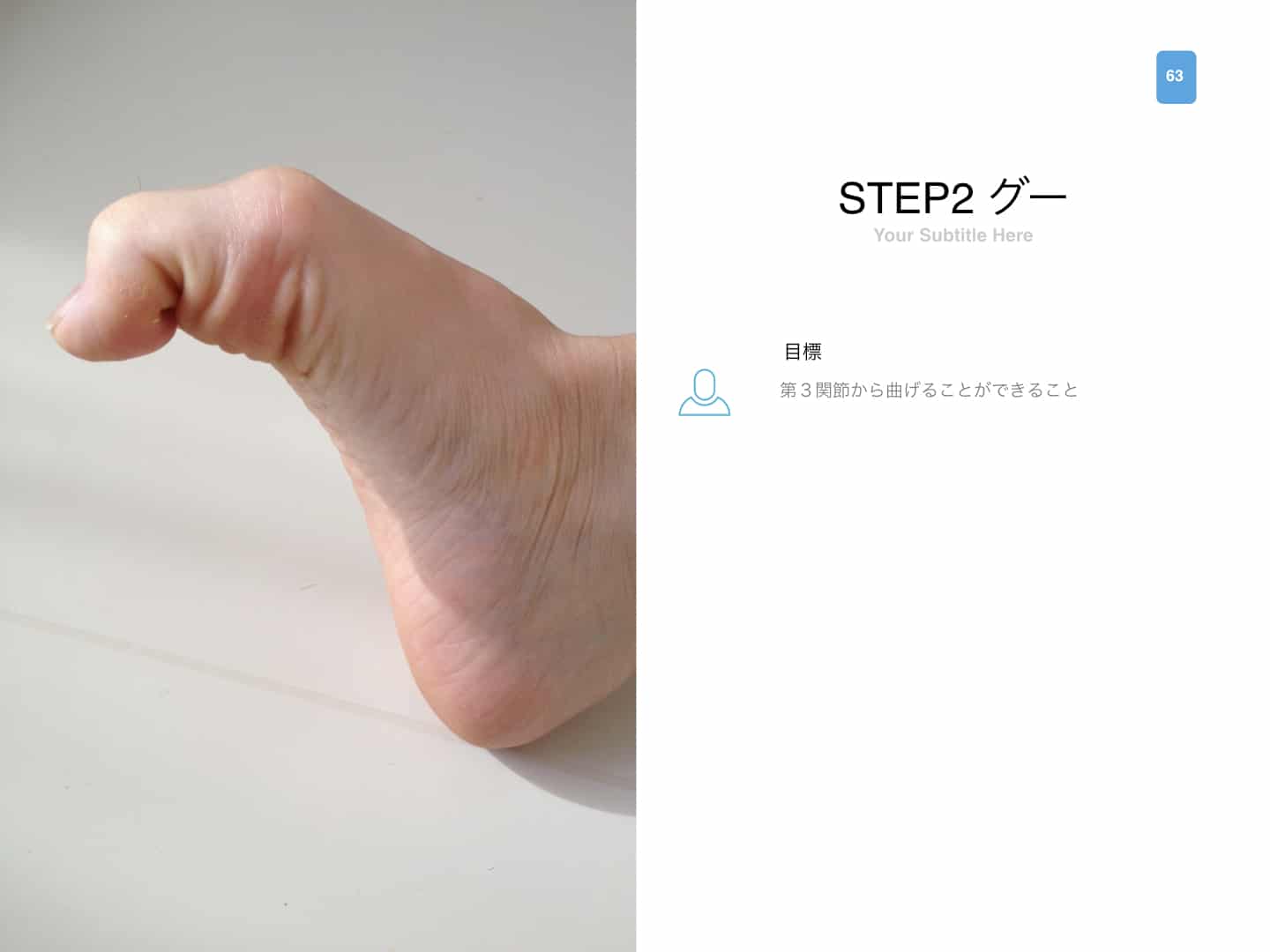
Can you do enough goo to make a cobble like the fingers of your hand? If you can bend firmly from the third joint, you have passed the test.
Can you do thumb chokes?
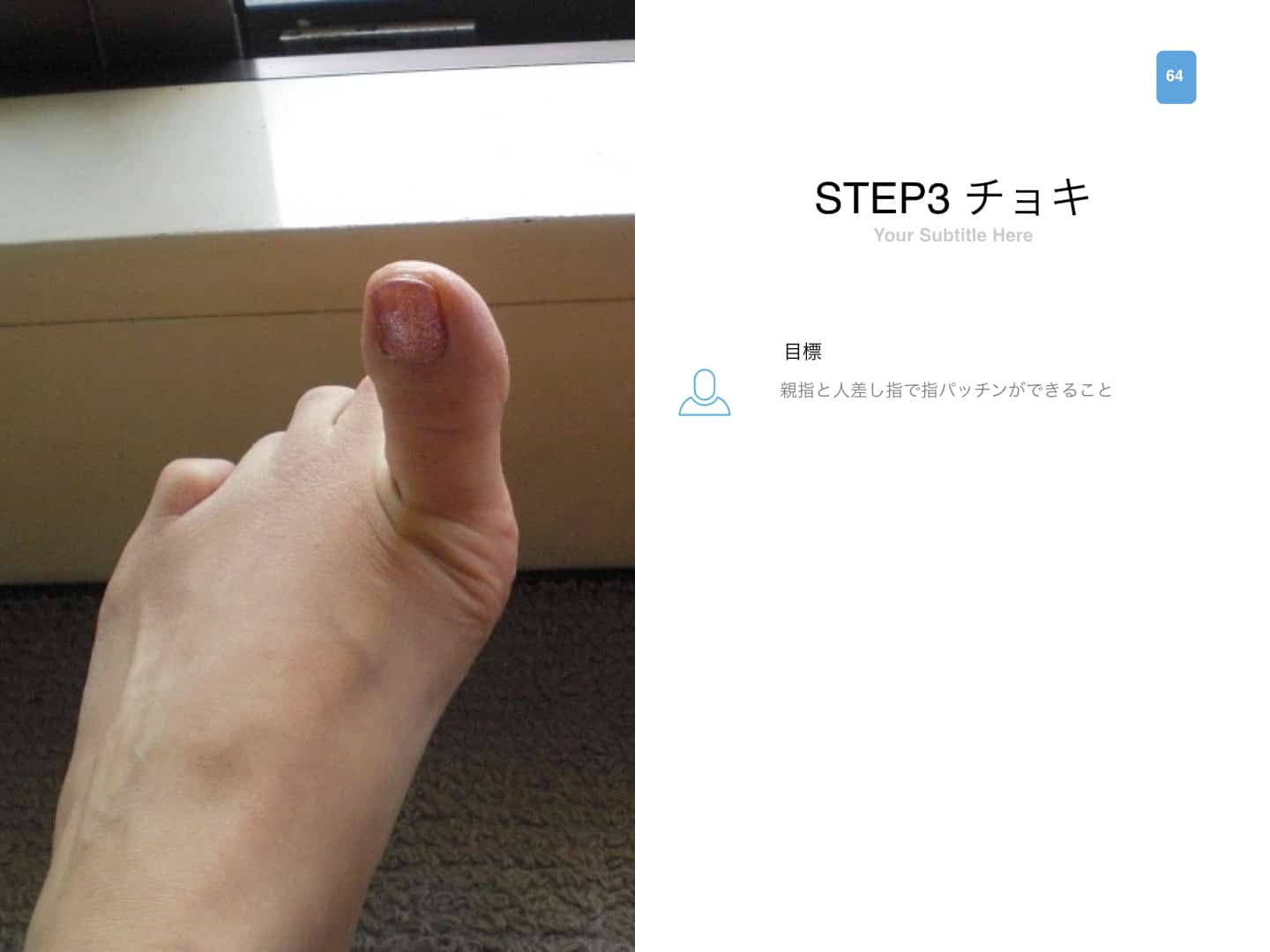
Can you play the thumb and index finger strongly? If you can do it with a "snap" sound, you have passed the test. If you can play the choki without any problem, you will be able to kick the ground with your thumb when you walk, which will prevent your foot muscles from losing strength.
How to cure hallux valgus by yourself
It takes a certain amount of effort to restore the angle of the big toe, but as long as the effort is not neglected, there is a good chance that the little toe can be straightened, as in the people in the photo below. No insoles, taping, surgery, or other procedures are needed to treat hallux valgus.All that is needed is the correct knowledge and skills regarding hallux valgus.
Now let me show you how to actually cure bunions. There are several methods, but please try the method that can be cured without spending a lot of money first. If that does not work, let's move on to the next step.
Seven Steps to Cure Hallux Valgus
There are several STEPs. Some people are cured in STEP 1, but others have difficulty in healing due to various factors such as the shoes they wear and the way they walk. Try starting with STEP 1 first, and if you do not get any benefit, move on to the next STEP.
STEP1.Let's try the stretching method to cure hallux valgus, Hironoba Exercise!
What kind of gymnastics is Hironoba Gymnastics?
Hironoba Exercise" is a biomechanical stretching exercise for toes, based on podiatry, devised and developed by Keiro Yuasa in 2008, to spread (=hiro) and stretch (=noba) the toes. For mild to severe hallux valgus, toe stretching can improve symptoms.
(If your goal is to improve an illness or condition, the more often you do it, the easier it will be to see results.) It is surprisingly easy to do, so let's start by watching the video and practicing! Once you know how to do the exercises, you can easily do them before bed, in the bath, while watching TV, or anytime. First of all, try to do it for 2 weeks.
STEP 1 Sit on a chair or on the floor and place one leg on the thigh.
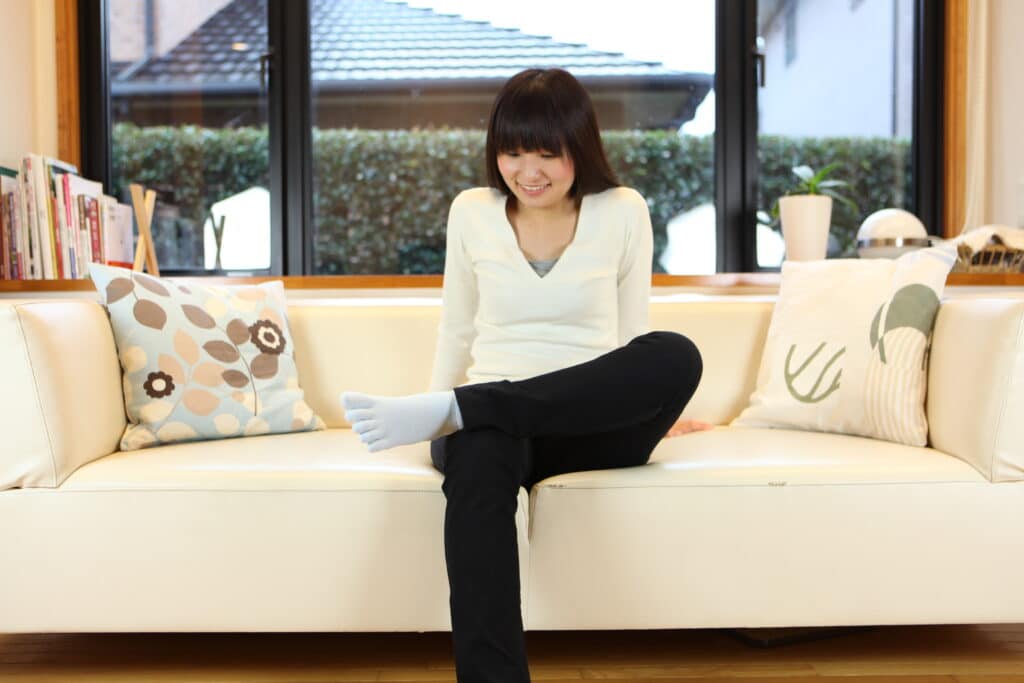
Tilt knees down as far as possible
...to prevent the ankle from turning upward.
Place feet properly on the thighs
STEP1-2 Check from above to make sure your feet are in the correct position.
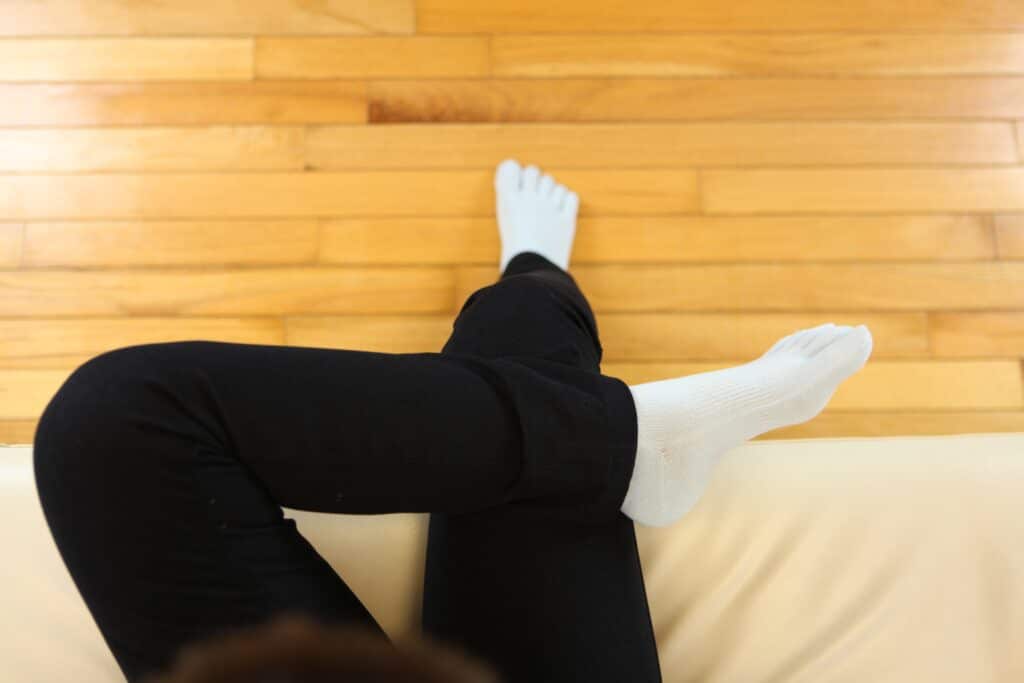
The back of the foot should be turned in firmly.
The ankle should come out slightly from the thigh.
STEP2-1 Place the fingers of your hand between your toes.
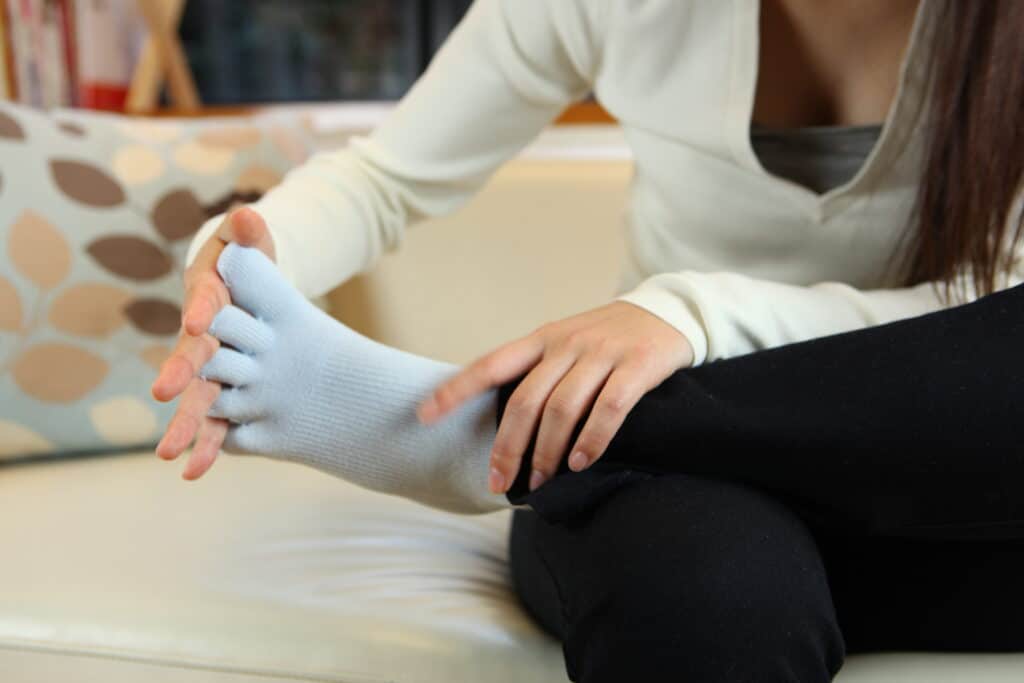
...Put the tip of one toe in the base of each finger.
Allow clearance at the base of the toes.
STEP2-2 Check the position of the inserted finger.
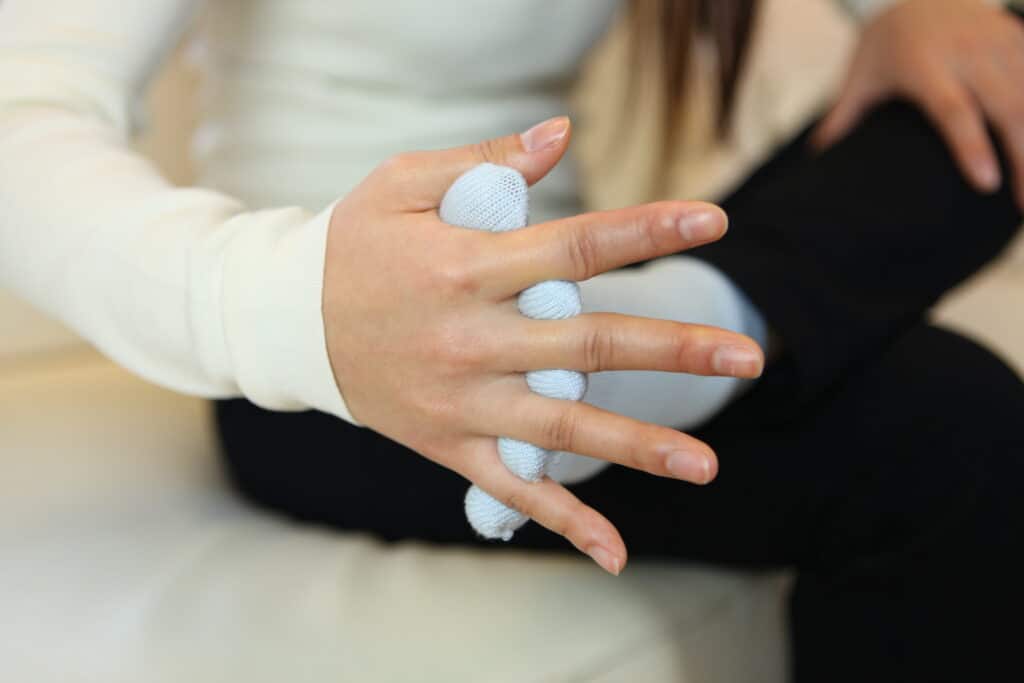
I feel like only the tips of my toes ride on the base of my hands.
...and toes snugly against the base of the hand.
STEP2-3 Don't put too many fingers of your hand between your toes.
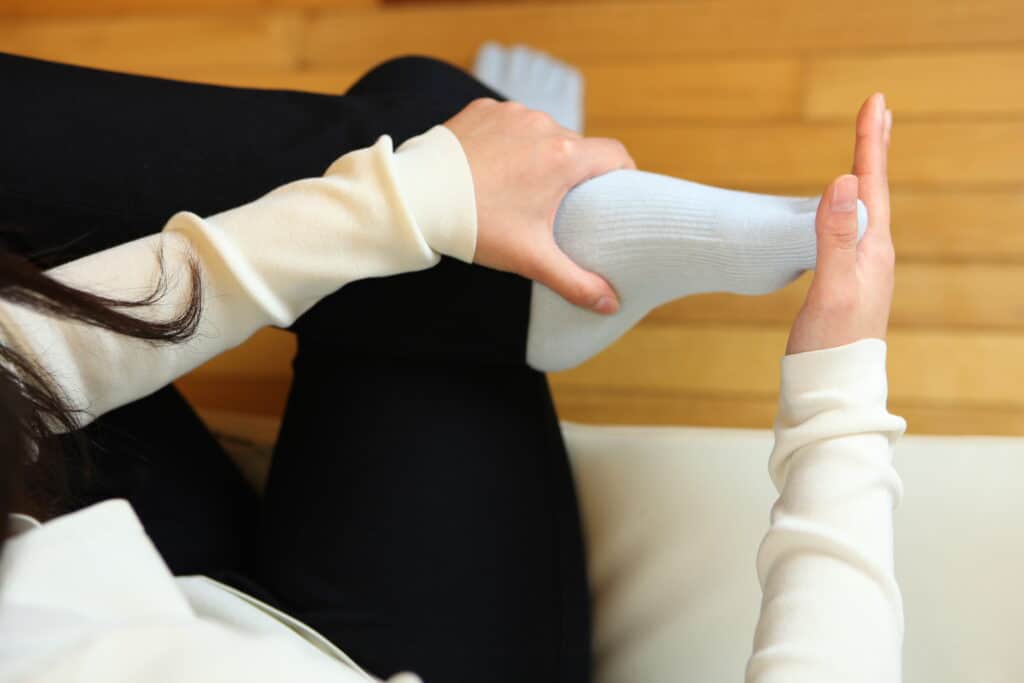
Ideally, the toes should not protrude from the fingers.
NG Be careful not to get into the base of the foot.
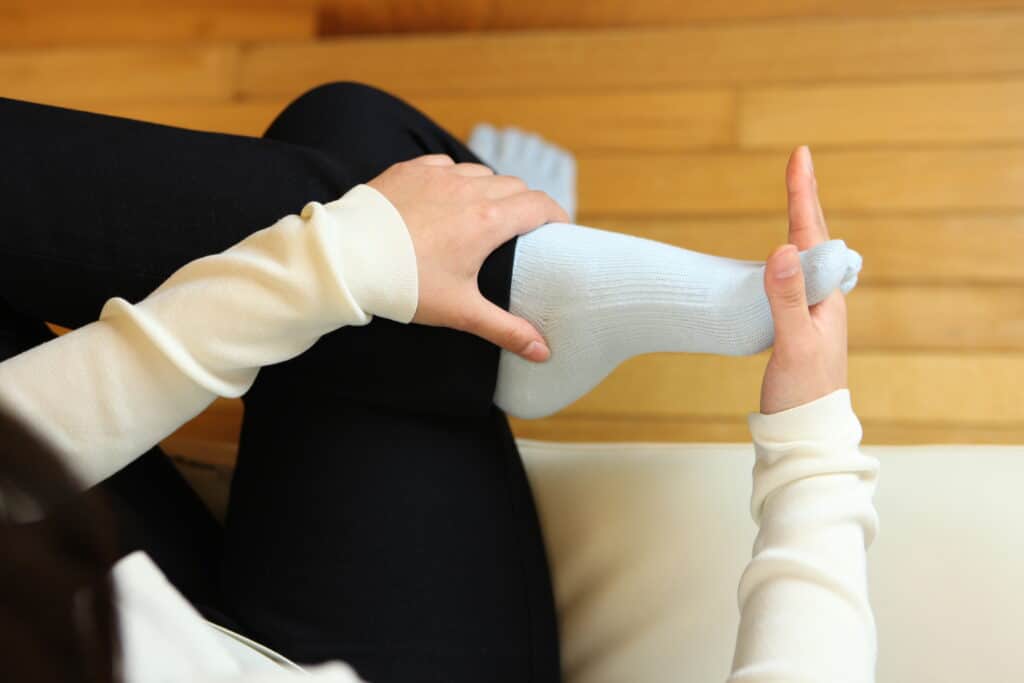
...If you put your fingers in to the base of the toes, you will not be able to bend them properly.
STEP3 Gently grasp the hand with the toes in it.
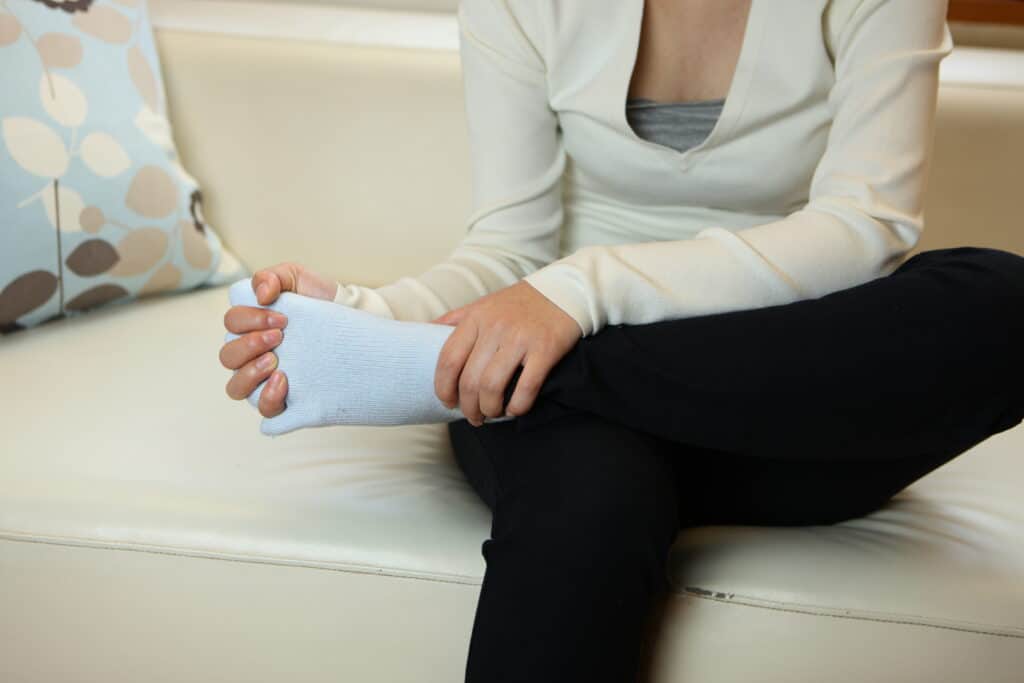
Hand comes to a little above the base of the toes.
Press the thumb of the foot lightly with the thumb of the hand.
gaffe
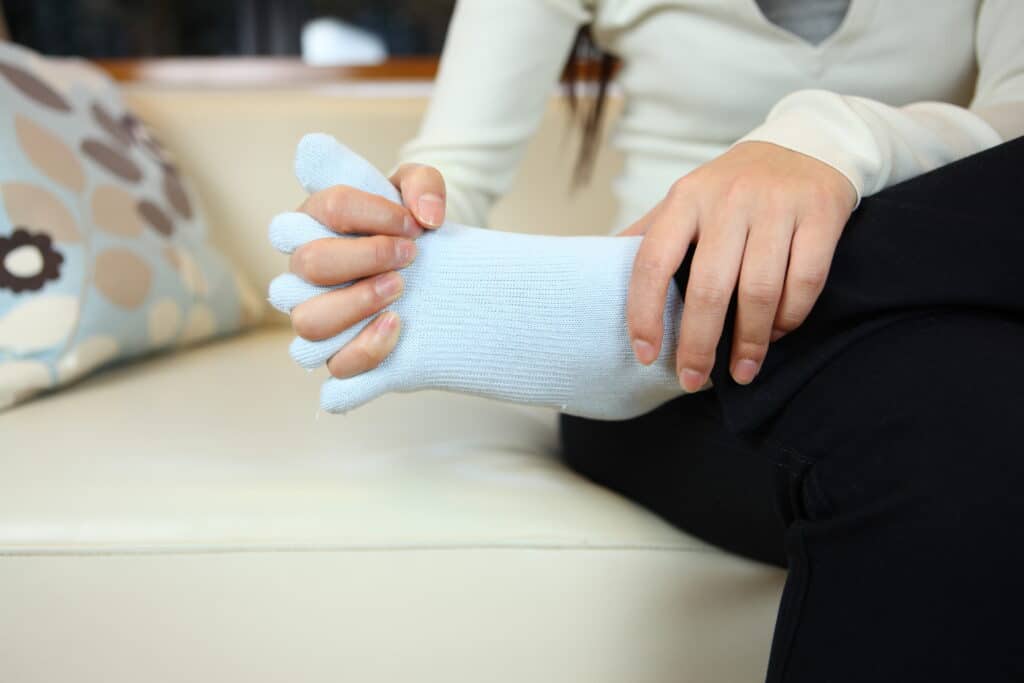
It is difficult to warp when the fingers of the hand are inserted all the way to the base of the foot.
STEP4 Turn your toes toward the instep.
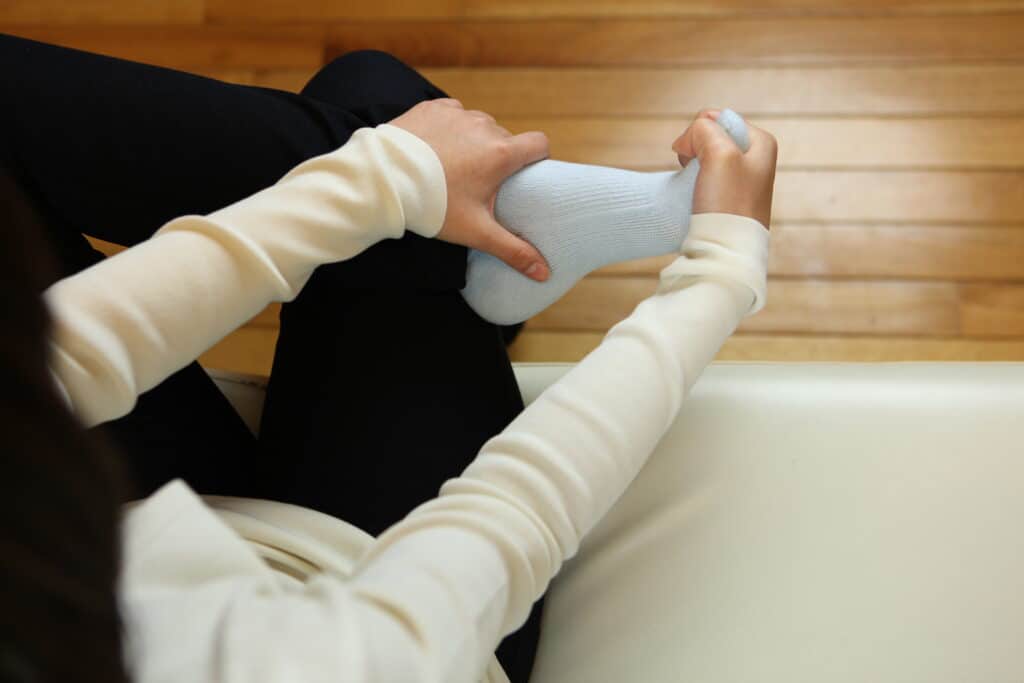
Gently and slowly warp
Press your toes with the base of your hand.
Ideally, the toe joints should be at 90 degrees.
(Do not overdo it if you are stiff)
Once warped, hold for at least 5 seconds.
(If stiff, hold for 30 seconds)
STEP5 Turn your toes toward the instep.
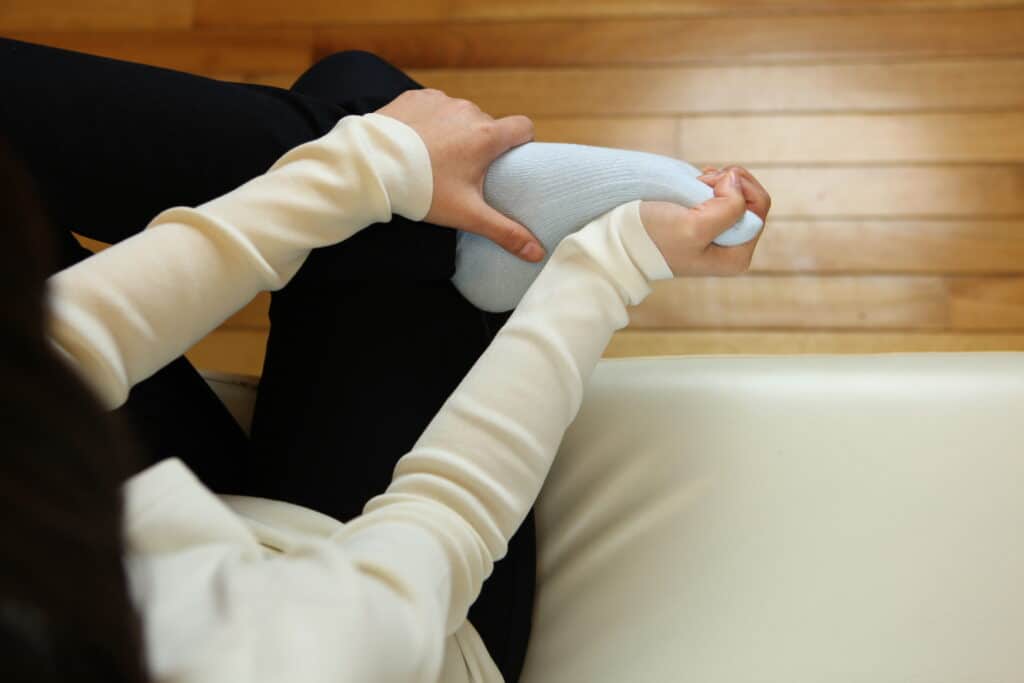
Gently and slowly
Warp the back with the image of stretching the instep.
Press the sole of the foot lightly with the whole palm of your hand.
Once warped, hold for at least 5 seconds.
(Hold for 30 seconds if stiff)
STEP6 Repeat STEP4 and 5
After repeating STEP 4 and 5, turn the opposite leg in the same manner. It is OK if you can do both legs for at least 5 minutes; if you are stiff, it is more effective to do one leg for 10 minutes.
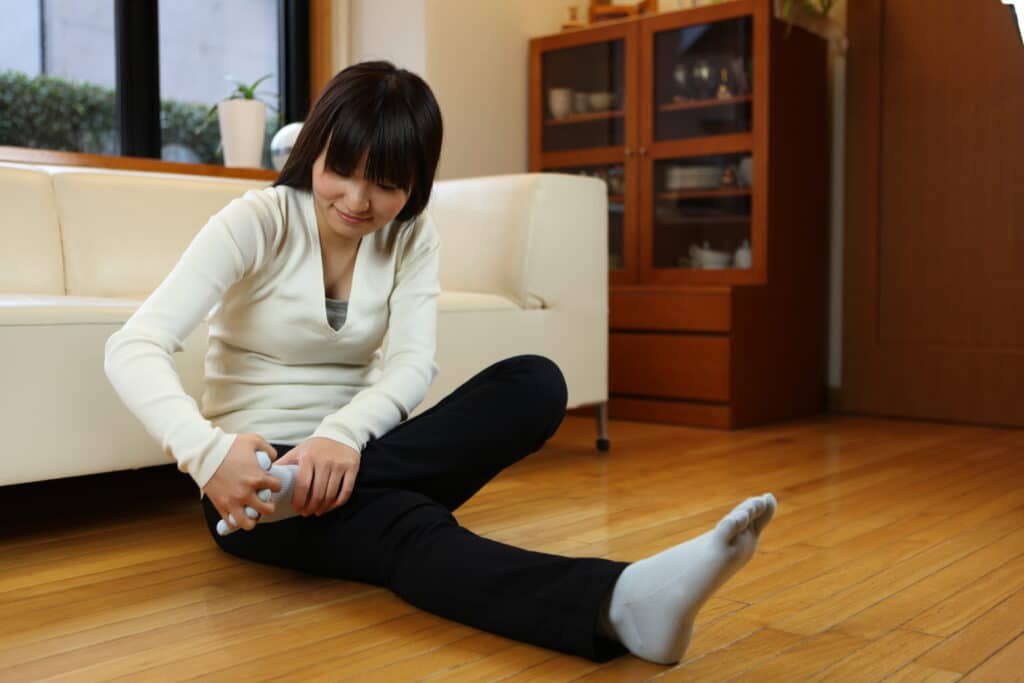
If it is difficult to do it yourself, have someone else do it for you.
Application of Hironoba Exercise (how to grab the little finger)
Hironoba Exercise Method Booklet
STEP 2. Avoid wearing slippers or slippers indoors.
Ankles are not fixed and toes are contracted
Many patients who come to me with foot problems wear slippers in the house. At first glance, slippers seem wide enough to take pressure off the toes. However, since the ankle is not fixed, walking is always unstable. As a result, the foot easily slips inside the footwear, causing the slippers to flop off with each step.
In an attempt to prevent this, the toes naturally become strangely strong and bent. This is the beginning of flexed toes, which leads to weakness of the foot muscles. Some people walk with their toes in the air to prevent their slippers from falling off, but this can also cause floating toes, so care should be taken.
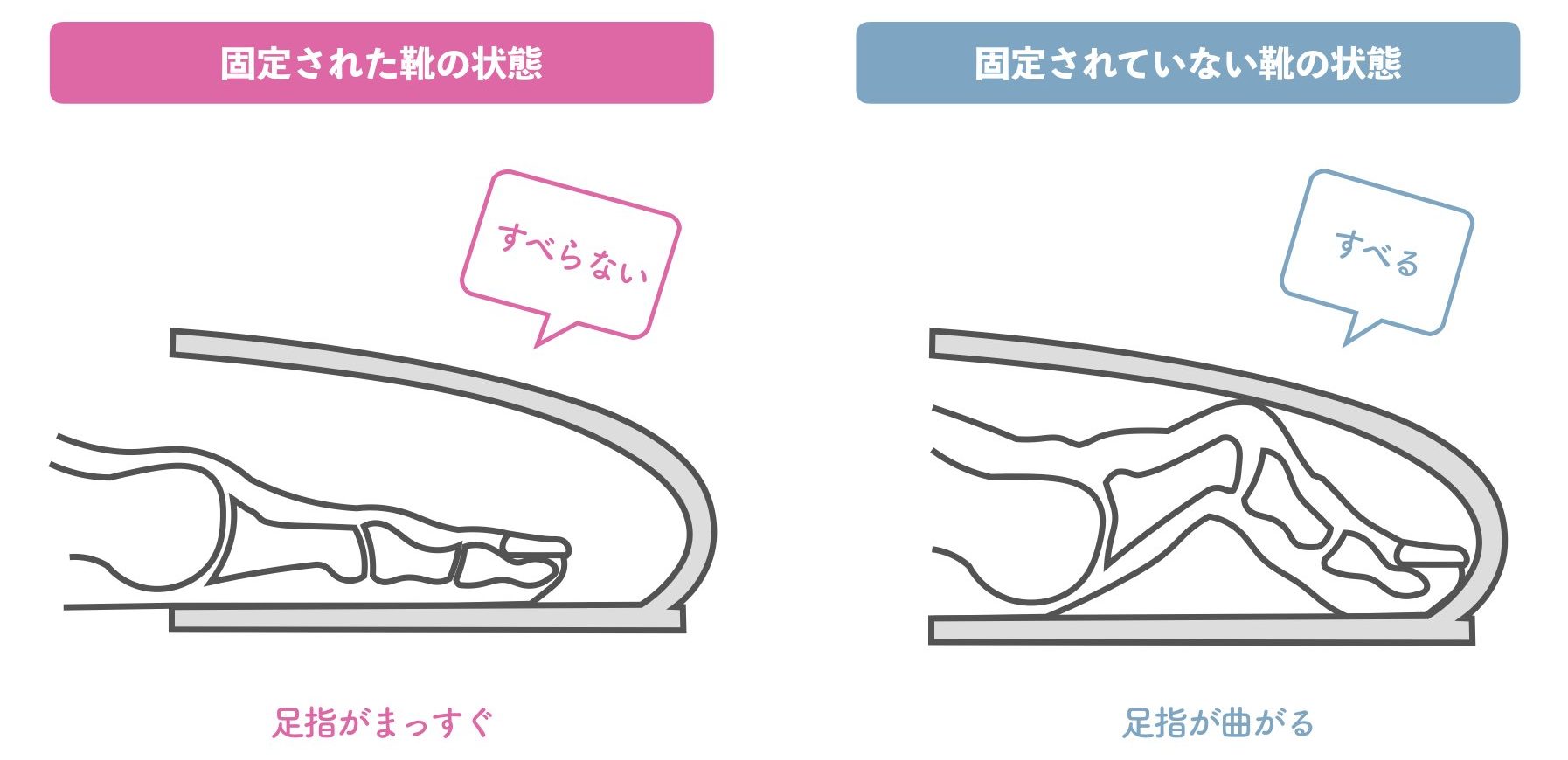
The picture below compares how the toes change between slippers and bare feet. Although they are the same feet, after wearing slippers for a while, the toes are bent and the big toe and little toe have become bunions or hallux valgus. To reduce the stress on your toes, either stop wearing slippers or shorten the time you wear them as much as possible. If you don't want to take them off because your feet are cold, wear leg warmers or other foot warmers to expose only the tips of your toes, or place a rug around your feet if you don't like to get your feet dirty.
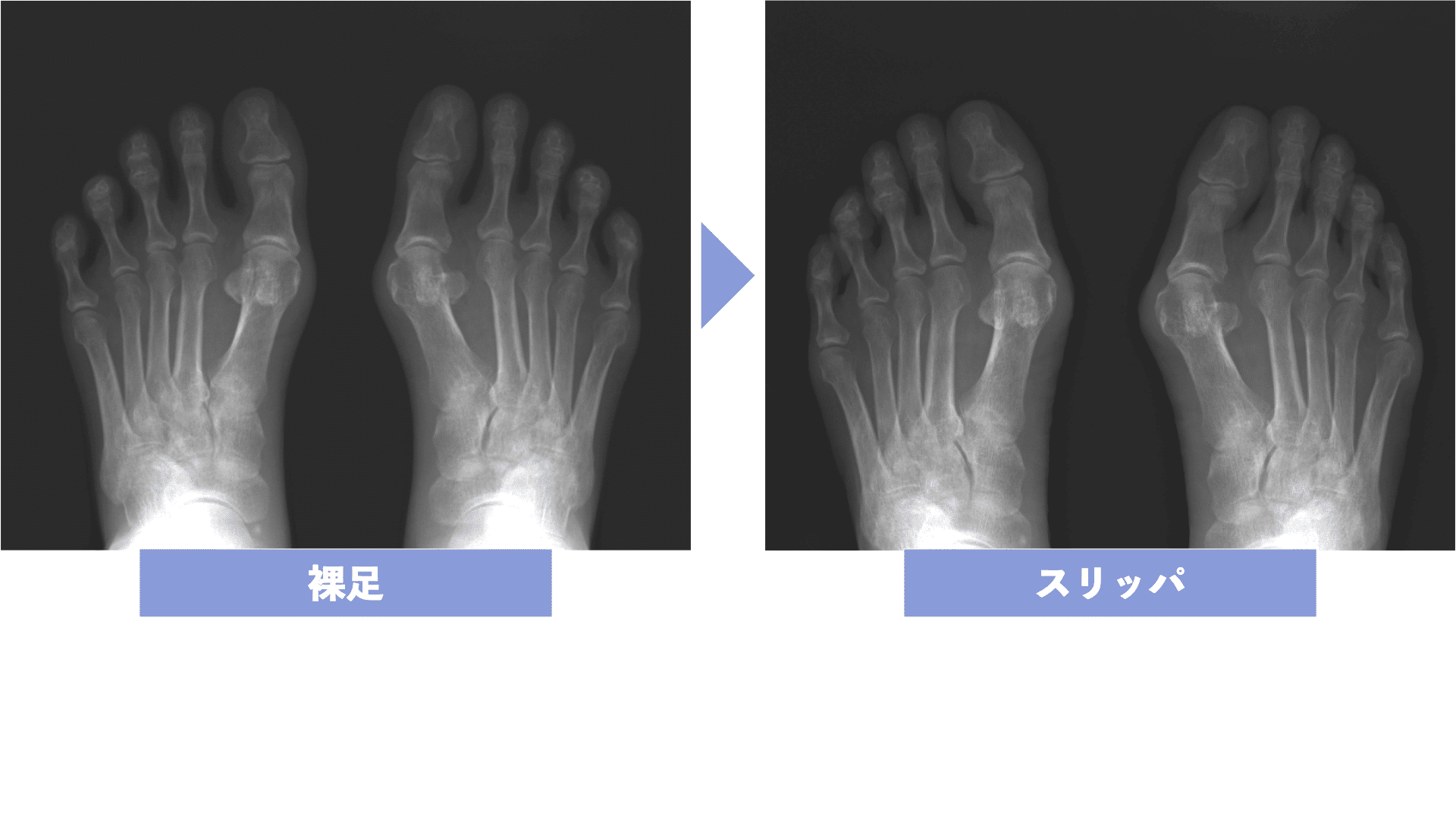
Women, in particular, spend a lot of time standing in the kitchen, so whether or not they wear slippers greatly affects the health of their feet. If you have been wearing slippers out of habit, why not take this opportunity to get rid of them?
The same is true of zori, in that they do not hold the ankle in place. These days, we see many people wearing them to strengthen their toes and because they were worn by people in the olden days and are therefore healthy. But did you know that the original zori actually had a kind of cord to secure the ankle? Since some time ago, ankle braces have been simplified for the sake of fashion, but we need to be careful not to have the wrong impression that "old-fashioned = healthy".
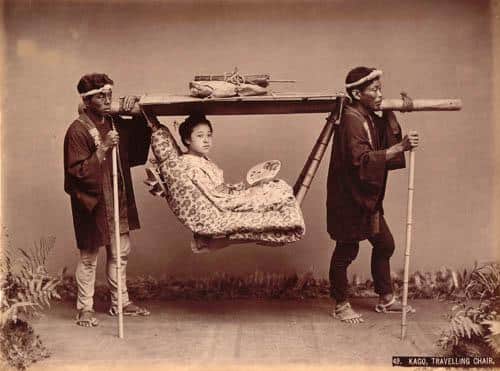
STEP3: Corrective support socks to improve hallux valgus
To maximize the effects of Hironoba Gymnastics, we developed YOSHIRO SOCKS, five-toed socks for correction, based on podiatry, to help toes spread even more easily, leading to more effective improvement of hallux valgus. For those with severely deformed toes or those who wish to obtain quick results, we recommend the combined use of HIRONOBA EXERCISE and YOSHIRO SOCKS.
State-of-the-art fibers, state-of-the-art construction.
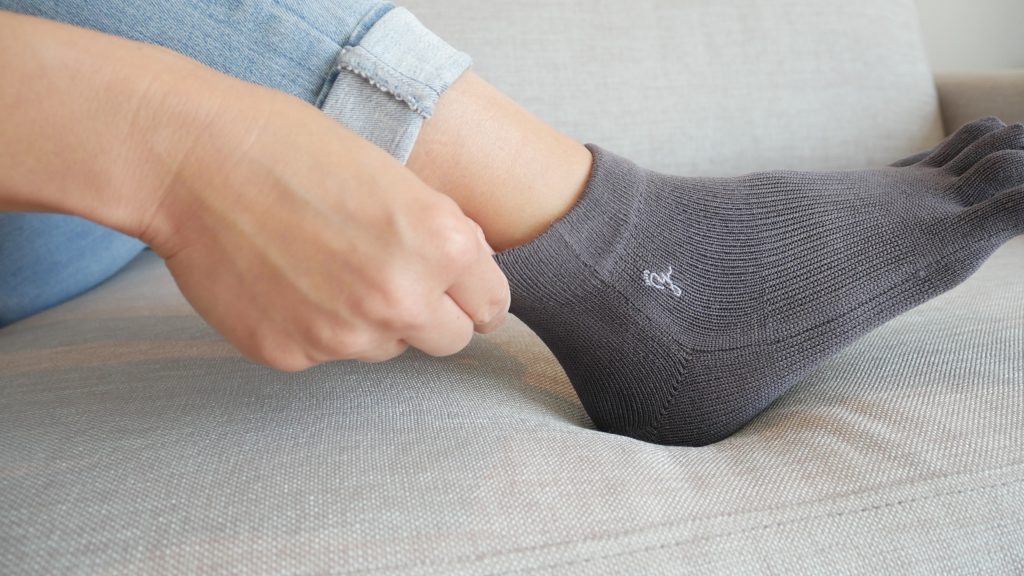
The 19 years of knowledge and experience in foot education that I have accumulated as a physical therapist specializing in toes have been condensed into these 5-toed socks. Simply by wearing the socks, the toes are expanded and stretched, and the body is restored to its natural posture and athletic ability. This is the only reason we developed YOSHIRO SOCKS.
Toes spread naturally just by wearing socks
Shape memory structure that approaches the ideal foot shape
Slip, the biggest cause of toe deformity.
Adoption of special fibers that reduce to the extreme
Physical therapist with a proven track record specializing in toe
Five-finger socks with revolutionary foot education developed by Keiro Yuasa
From thread production to sewing and inspection
Made in Japan with the utmost care
The goal was to,
Human's original straight toes
Scientific Effects of Corrective Socks on Hallux Valgus
Changes to the toes
YOSHIRO SOCKS prevents deformity of the little toe, which is caused by muscle weakness in the sole of the foot, by making the muscles of the foot more efficient and usable. 90% of Japanese people have floating toes with crouched toes that prevent them from using their toes. But YOSHIRO SOCKS have a structure that allows the toes to grip the ground firmly, which improves unconscious huffing power and restores the muscular strength of the sole.
hallux valgus
The angle of the big toe at the start is25.1°, and
The angle of the big toe after 8 weeks is5.3°
The average value at the 8th week was 19.8° improvement in the angle of the big toe compared to that at the start. The action of improvement of the angle of the big toe was confirmed.
3 Difference between the mean before the start and at the 8th week
*Graphs show average values in clinical trials.
*Results may vary from person to person and are not guaranteed to be 100%.

Thus, YOSHIRO SOCKS are made using a special manufacturing method (patent pending) that naturally widens closed toes and straightens bent toes and floating toes just by wearing them.
Difference from ordinary five-finger socks
Shape of YOSHIRO SOCKS
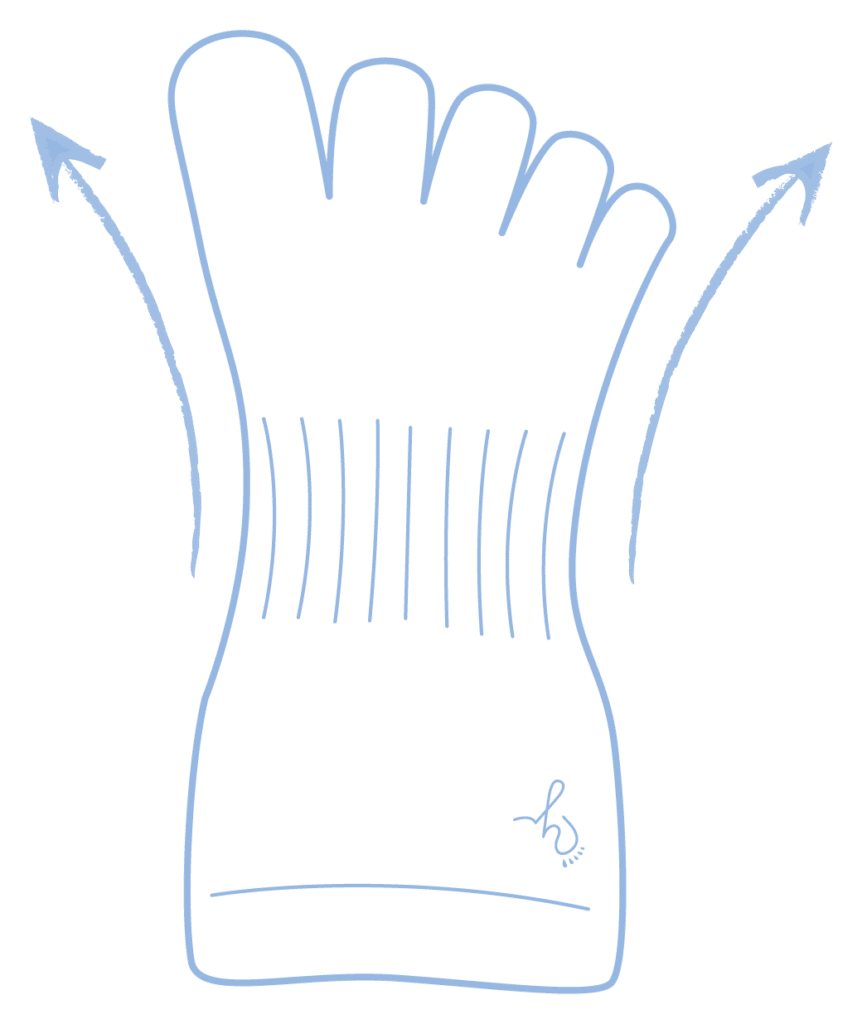
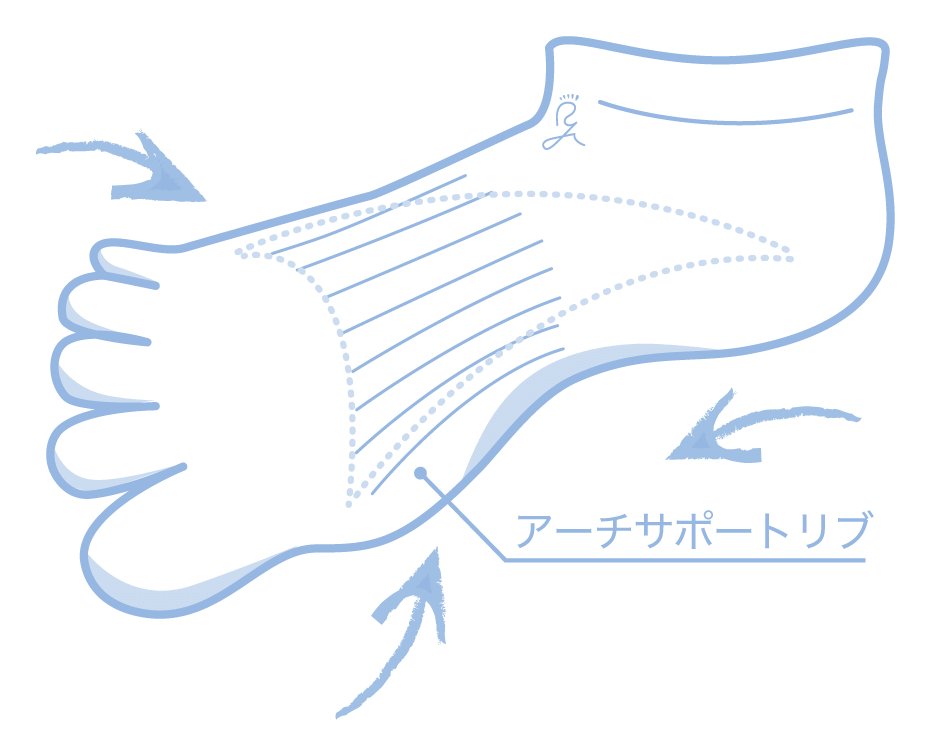
YOSHIRO SOCKS have a special manufacturing method (patent pending) that naturally spreads the toes into an ideal shape, and a shape-memory structure that keeps them in that state.
General 5-finger sock shape
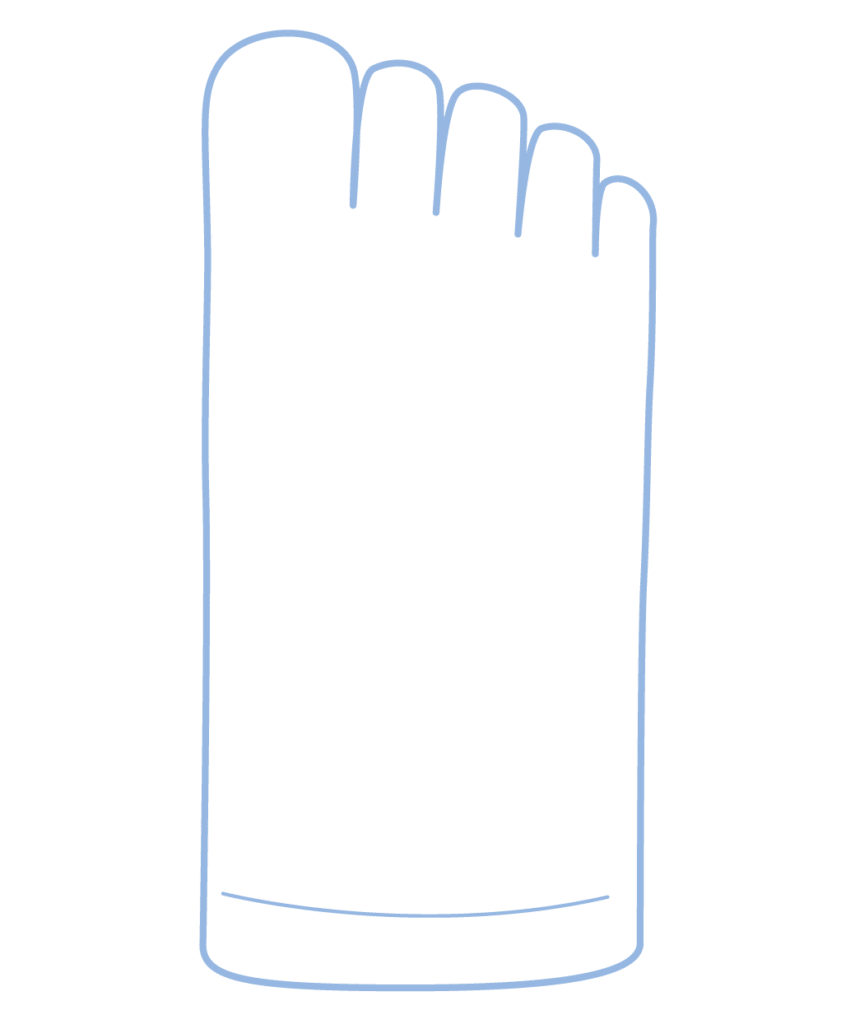
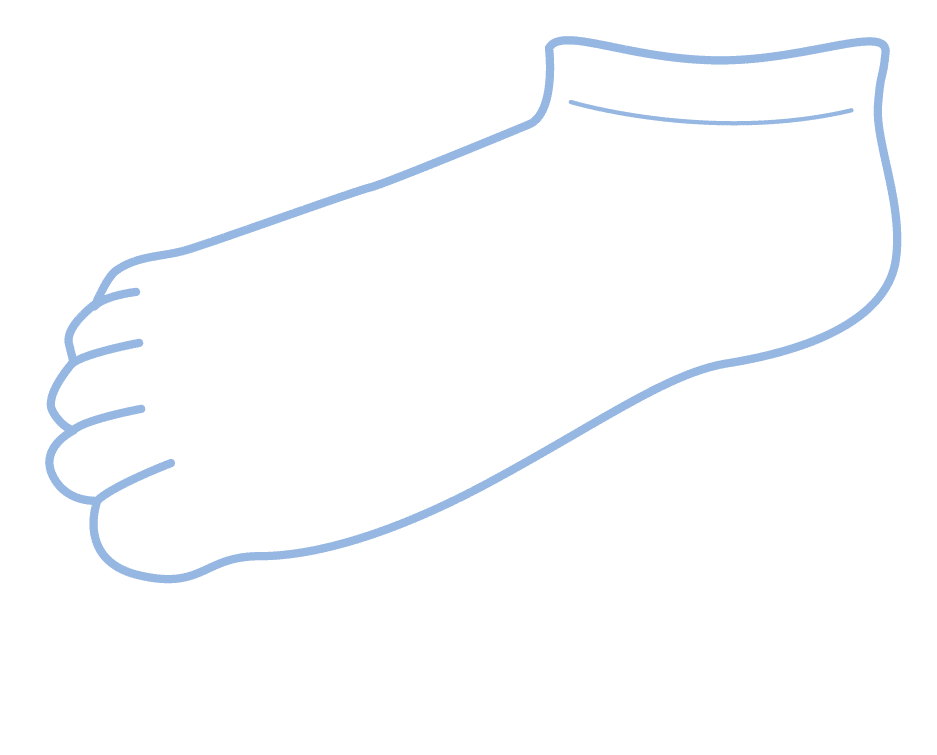
Conventional five-toed socks are woven in a straight line from the top of the foot to the tip of the toes, so they have no corrective power and do not bring the foot closer to the ideal foot.
Special non-slip fibers prevent toe deformities.
The biggest cause of flexion toes (kagayubi), is foot slippage. When the foot slips in the shoe, the toes bend down to apply the brakes. YOSHIRO SOCKS prevent bent toes by weaving in highly slip-resistant fibers.
Made in Japan with the utmost care and attention to detail, one pair at a time.
They are produced at a factory in Japan on a seamless machine called a WHOLEGARMENT® machine (SHIMA SEIKI), and each pair takes a whopping 20 minutes to sew (about 5 times longer than on a standard sock knitting machine). From finishing to packaging, inspection, and shipping, we are committed to making our products in Japan.

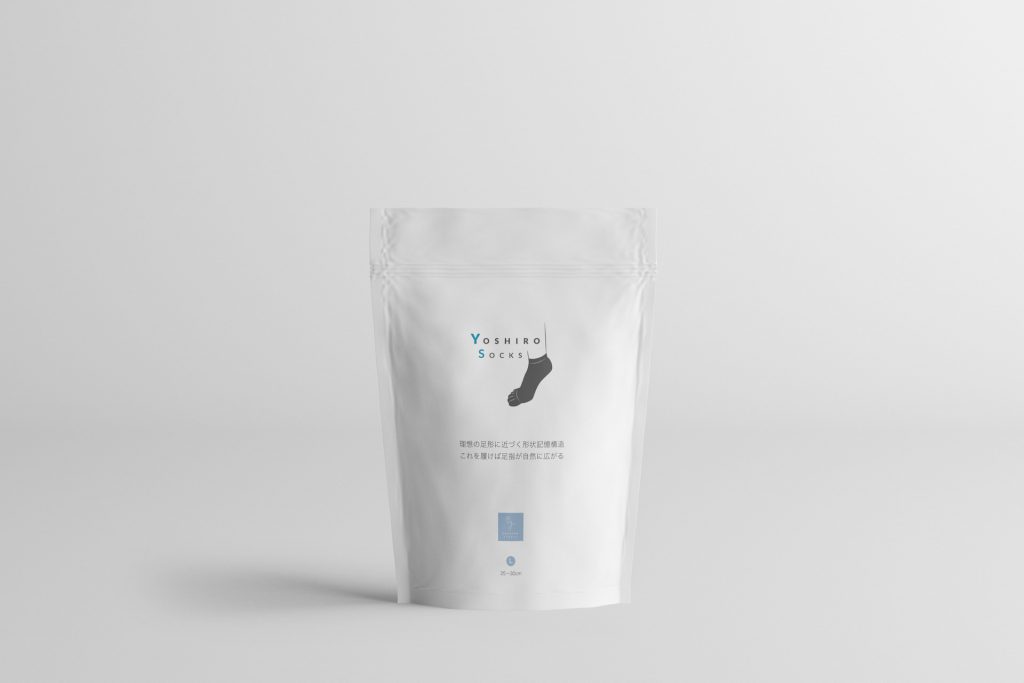
YOSHIRO SOCKS
Price: 3,850 yen (tax included)
Color: white and gray
Size: 3 sizes (S, M, L)
Video on how to put on socks
STEP4.How to choose the right shoes to heal hallux valgus
Basically, if you do not wear shoes, you will not walk badly. Barefoot, however, improves hallux valgus faster because of the unconsciousness of the correct walking style, but in modern society, we are a shoe-wearing culture, so here we will show you how to choose laces to improve hallux valgus.
Does the toe move functionally in the shoe?
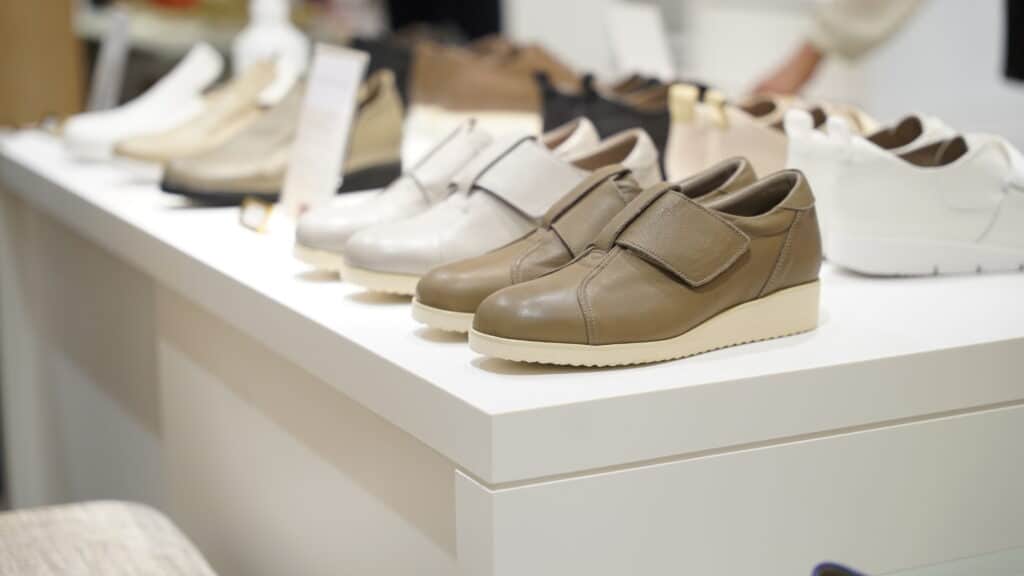
Shoes play a major role in toe deformity, and in the case of YOSHIRO STUDIO, the criteria for shoe selection areCan the toes move functionally in the shoe?"The first is If the toes continue to be tight and cannot be moved, the muscular strength of the entire foot will deteriorate. This can cause open toes, bunions, flat feet, and a variety of systemic symptoms.
Ideally, the shoes should be able to create a barefoot condition. However, if the shoes are too tight, the toes will bend as they try to hold on to the foot that is sliding around in the shoe. Here are some tips for selecting shoes that protect the feet from the ground while at the same time not interfering with the function of the toes.
Five or more doves
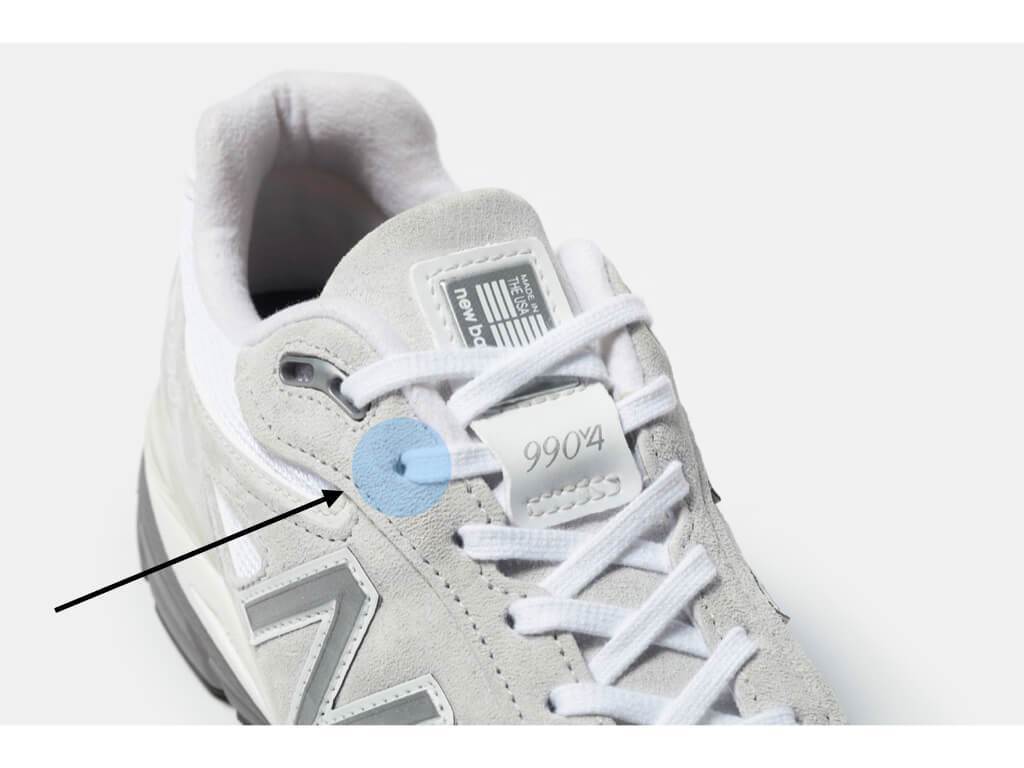
Shoelaces have the role of taping the shoe and foot together. The more dovetails (holes through which the laces are threaded), the more difficult it is for the foot to slip inside the shoe, creating an environment that prevents flexing of the toes.The foot is more stable when secured with a flat string that is supported by a surface rather than a round string that is supported by a point.
one's heels are stiff
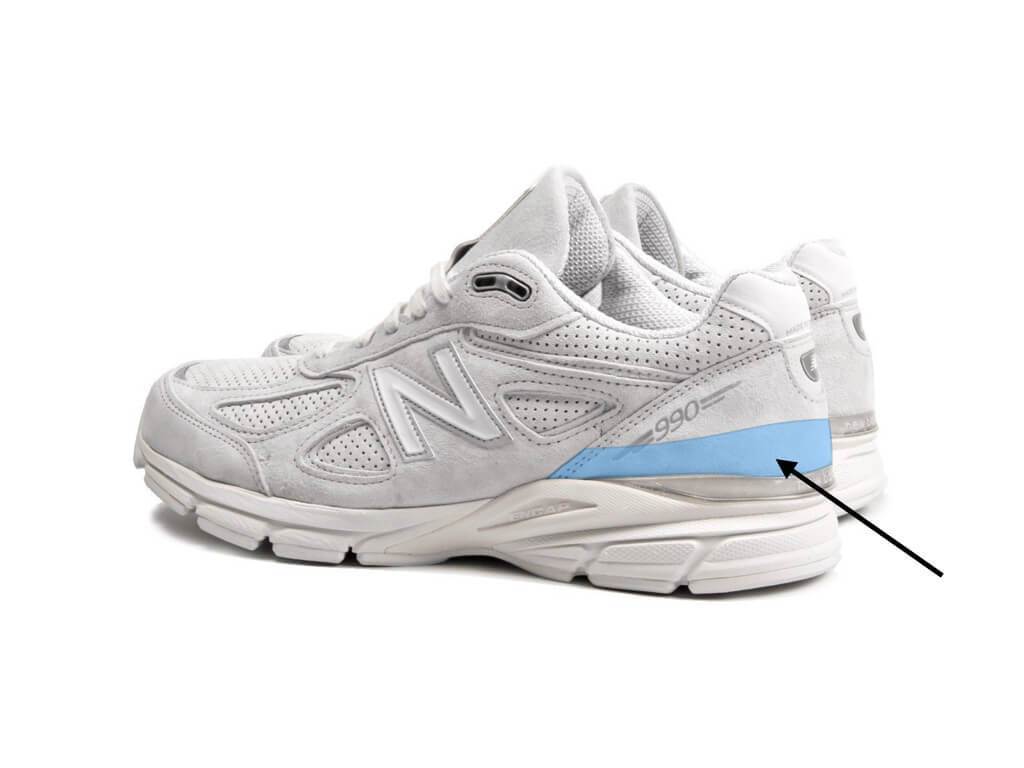
The heel of a shoe (heel counter) has the same function as the back of a chair. If you drive a car without a backrest, your body will tire quickly. Similarly, if the heel counter is firm enough not to be crushed when pushed by hand, the heel bone of the foot is supported in the shoe, thus stabilizing the foot in the shoe. There will be less lateral blurring and the toes will be less likely to bend.
torsion-free
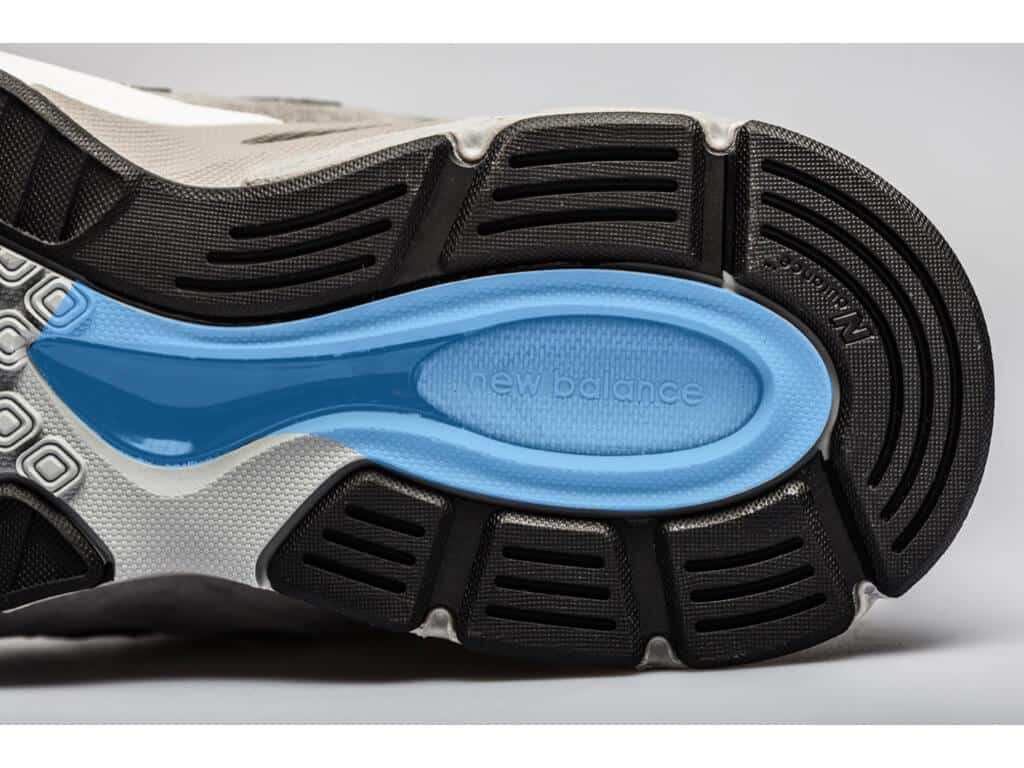
When walking, a load of two to three times your body weight is placed on your shoes.Soft shoes are like putting your foot on konnyaku. We recommend shoes with a strong core called a "shank" on the bottom that prevents the shoe from twisting.
Toes not protruding from insoles
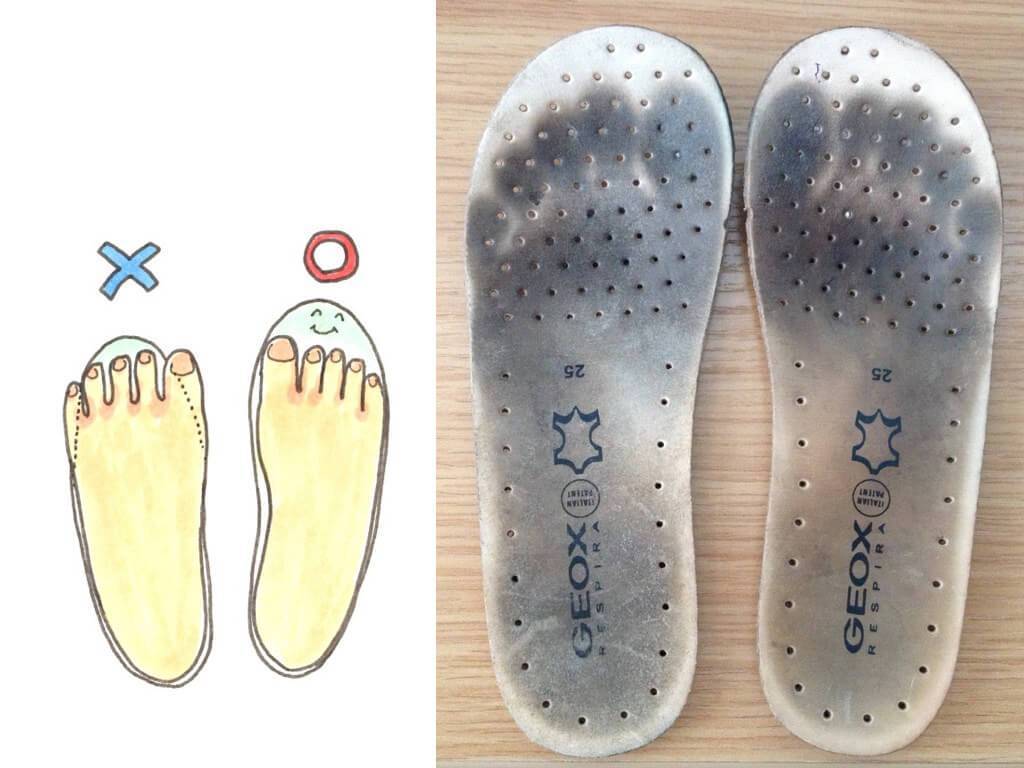
Take out the insoles and place them on your feet. If your fingers stick out, you are in a tight fit in the shoe, the same condition as if you were wearing high heels.
Shoe size is based on foot length + 1 cm
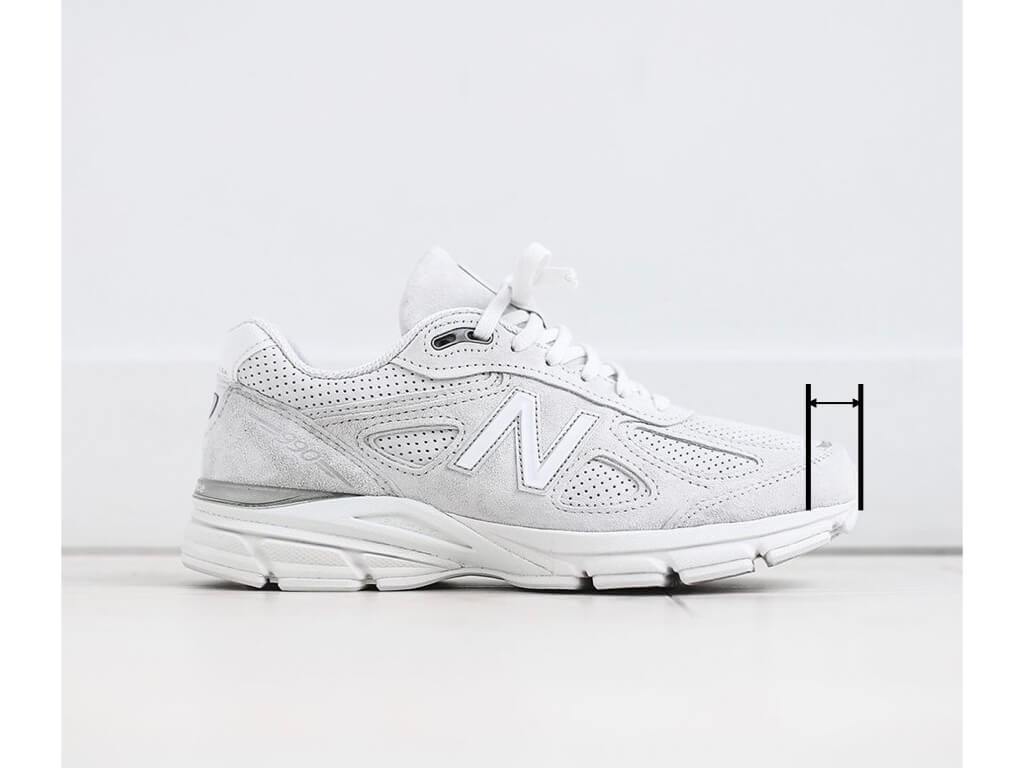
For the toes to move freely in the shoes,At least 1 cm of excess (discarded) fingertip is required.Measure the length of the left and right foot while standing, and choose shoes that fit the longer foot. If there is an excess of about the width of your index finger between the tip of your toes and the tip of the insole, you are good to go. Note that toe care will increase or decrease the length of the foot, so it is recommended to re-measure every six months.
Regular shoe replacement.
The heel is basically the life of the shoe, so no matter how good the shoe is, if the heel is stepped on or the sole is worn out, it is the life of the shoe. The condition of the shoe expresses the condition of the body, so too much deterioration can put a great burden on the body as well. If the heel of the shoe cannot be repaired,We recommend replacing them every six months to a year.However, even if the correct shoes are selected, if they are worn improperly, the desired effect will not be achieved.
Shoes recommended by Keiro Yuasa
walking shoes
Harmek (Japanese brand of haloperidol)
Simple Soft Sneakers
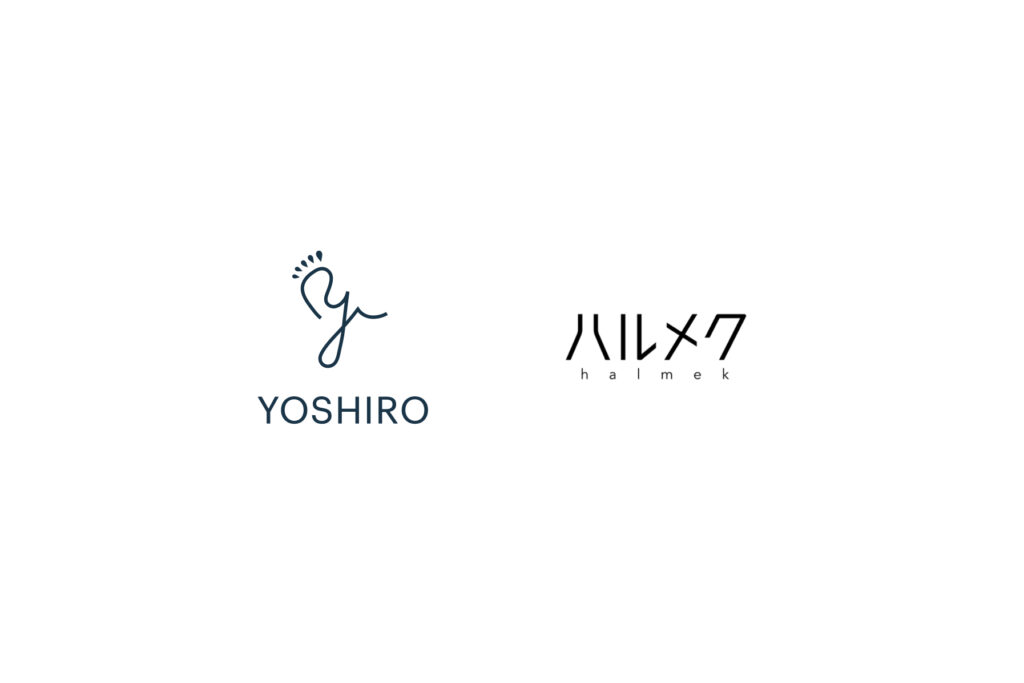
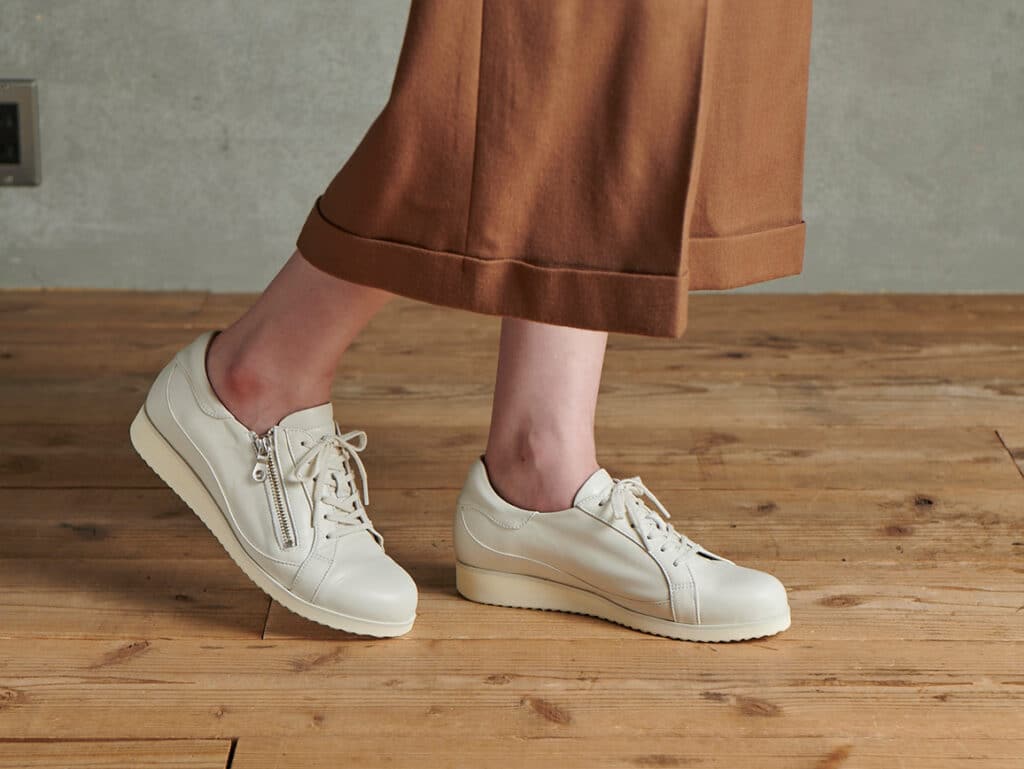
For the purpose of correcting feetIn pursuit of shoes that surpass the NB1400 and 990 series asOriginal shoes jointly developed by Keiro Yuasa and Halmek... The difference from shoes on the market is that they are not just easy to wear. The patented YOSHIRO INSOLE is also a standard cosmetic feature. It is as if you are walking on clouds. Keiro Yuasa reviewed all the design and materials, and was involved in everything up to manufacturing.Flagship YOSHIRO MODEL is now available!I will do so.
Pumps for work
Fit Partner
The Fit Partner, developed by BMZ for cabin attendants as a pump that can be run in, is characterized by less fatigue even after long hours of standing or walking long distances.
business shoes
SPH4501WSR
Tsukiboshi is proud to offer Japan's finest handmade business shoes. If the heel is repaired repeatedly, one pair can be used for 10 years, and you will not get tired at all even if you walk for a long time.
Keiro Yuasa's Favorite Shoes
walking shoes
New Balance 990
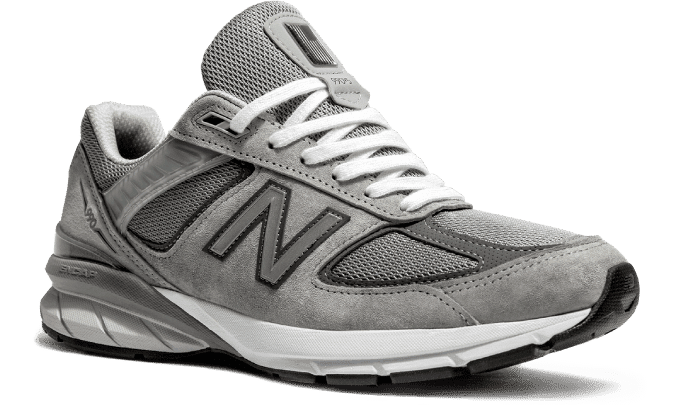
The M1400 and M2040 are no match for this shoe. This is the pinnacle of men's shoes.
pumps
LOUIS VUITTON
LOUIS VUITTON is well known, but what is less known is that its pumps are made with a wooden pattern for Asian customers. No other heels are so easy to wear once the toes are strengthened.
business shoes
TANINO CRISCI
TANINO CRISCI, a well-known name among those in the know, had a great fit in both pumps and boots. Unfortunately, they were discontinued in 2011 and are no longer available.
STEP5. Tighten the shoelaces firmly.
There are two main types of shoelaces: round laces and flat laces. Round laces press down on the instep at a point, while flat laces press down on the instep at a surface, so flat laces are more stable when tightened. There are two types of material: synthetic fiber and pure cotton. While synthetic fibers are stretchy, they have less strength to hold the instep in place. Pure cotton, which does not stretch easily, maintains its holding power and is more durable. Therefore, I use special pure cotton.
Shoelaces are like ligaments that connect bones to bones. When shoelaces are stretched, they fail to hold the foot firmly in the shoe, causing the foot to slip and the toes to become deformed. Therefore,For people with bunions, we recommend replacing shoelaces before they stretch (every 1-3 months).
Tighten the laces in a standing position.
There are many ways to tie a knot, but in this article, we will introduce the "overlap method" for walking. In this method, the knot is threaded from the front side to the back side of the shoe laces. The last knot near the ankle is tied from the back side to the front side. Tie the knot, taking care to make the left and right sides as even as possible. Ideally, have someone tie the knot while you are standing (or sitting if you are weight-bearing), but if you are alone, just make sure to tie the last knot securely.
STEP 6: Change the insoles of the laces you are wearing.
Pig skin prevents slipping in shoes

Synthetic fibers and high-grade, good-looking, slippery leather are unsuitable for insoles.Once you remove the insoles from your own shoes. Put on your socks and try to slide your feet on the insoles. If it is slippery enough to slide on the floor barefoot, there is no problem, but in most cases, you will find that it slips on smoothly. In the case of pigskin, which is considered to be the closest to human skin, the skin has a grain called a grain, which creates moderate friction and makes it particularly difficult to slip. Slippery feet can cause deformity of the toes, which can lead to open toes and bunions,Preventing slippage is important for improving hallux valgus.Of course, the shape of the insole itself is also important to support the sole. However, it is even better if you pay attention to the surface material of the insole.
How to make pigskin insoles
This video explains how to customize insoles with pigskin. We hope you find it helpful.
Regular replacement.
If you continue to use the pigskin, the surface will also become slippery and your feet will gradually slide on it. If possible, try to replace the pigskin once every six months. There are two sides of pigskin, the suede side and the suede side, but basically either side can be used. The suede side is raised and has a very high non-slip effect, but it is more difficult to put on when putting on shoes, so we recommend using the suede side as the surface if the shoe opening is wide.
There are non-slip insoles in ready-made products.
New Balance has also released an insole that uses a full-length surface of NanoFront, which exhibits high slip resistance, for improved slip resistance. Although functionally inferior to pigskin, it is convenient because it can be easily inserted into shoes.
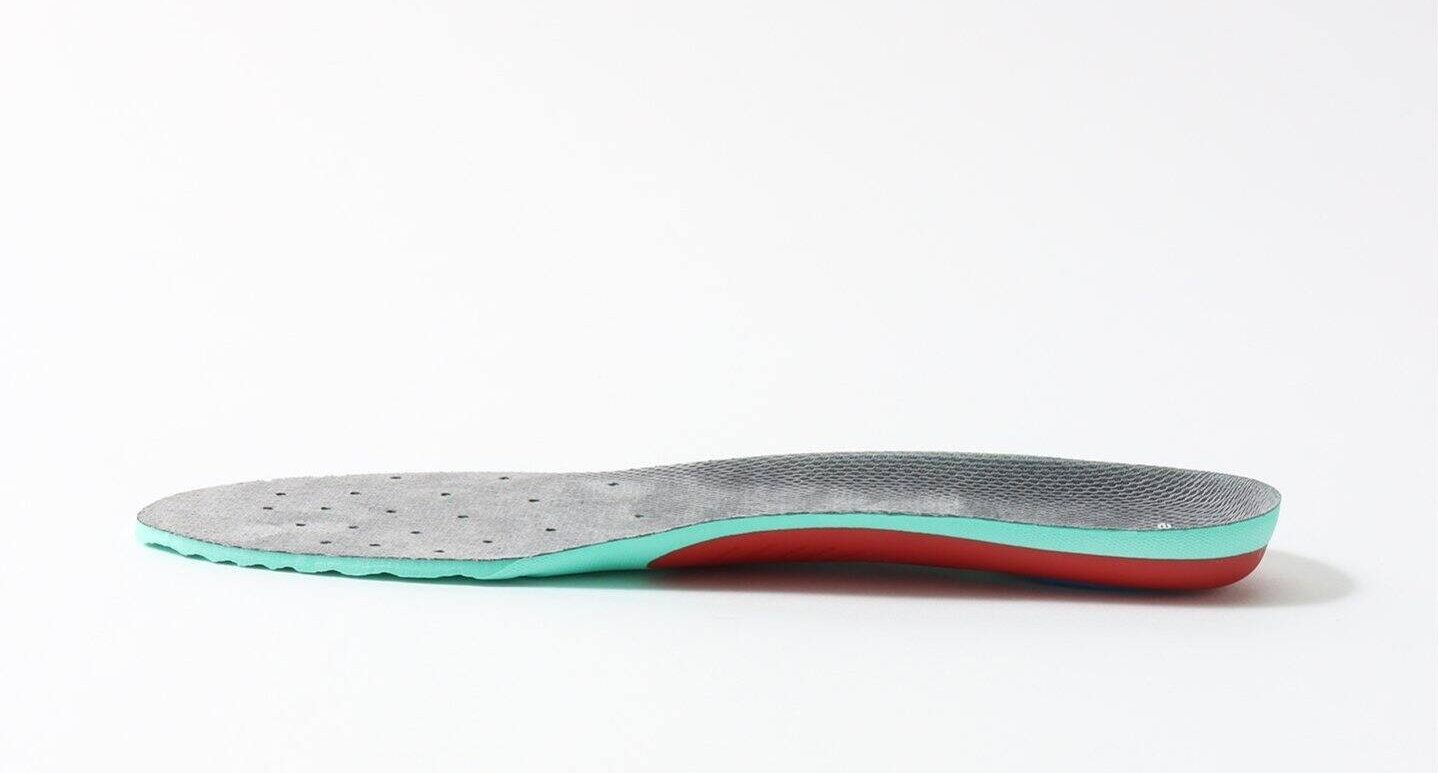
STEP 7. Walk outside at least 6,000 steps a day.
Walking without heel landing on the straw uses the toes. On the other hand, a big toe heel landing does not use the toes. Therefore, leg distortion tends to increase. If the outer soles of your shoes are worn down, you should expect this tendency. If your work requires you to walk in this manner, try walking with a small step at the end of the day as if you were brushing your teeth.
To develop the habit of walking with a small step, try walking backward first. Once you have a feeling that your stride naturally becomes smaller and you can kick the floor with your toes, try walking forward with the same stride and speed.That is the secret to making your body learn to walk with a small gait.
Can you describe the feeling as if you were wearing a kimono and walking with your knees below your knees? Or try walking around the house so that you don't hear the flooring. You should naturally walk in a small stride, using the entire sole of your foot. If you continue this way of walking for five minutes every day, you will naturally build up the muscles in your feet and improve your walking balance. You will have a healthy and graceful gait.
Use the entire sole of the foot with a small crotch.
The human body can use the correct muscles of the whole body (use muscles equally in front, back, left, and right) by walking with the toes, but shoes, socks, and the way we walk make it difficult for us to perform this function. Some of you may have suffered from knee or back problems due to walking, but that is because you have been walking with your toes bent. We hope that you will realize that walking with your toes spread apart will improve the distortion of your body through walking.
Aim for 8,000 steps
I have treated a total of 60,000 patients, and the borderline number of steps to cure hallux valgus is 6,000 steps per day. 8,000 steps will improve the condition relatively quickly. Please try to take as many steps as possible in your daily life. Please consider that the number of steps taken indoors will not be converted to the number of steps taken indoors because the toes are used in a different way.
References
1) Arnold H. Schneiderballen, Hammer- und Krallenzehen. korrektur ohne Funktionsverlust [Tailor bunion and digitus quintus varus]. MMW Fortschr Med. 2013 Feb 21;155(3):42, 44-5. German. doi: 10.1007/s15006-013-0171-2. PMID: 23573767.
(2) Fallat LM. Pathology of the fifth ray, including the tailor's bunion deformity. Clin Podiatr Med Surg. 1990 Oct;7(4):689-715. PMID: 2253170.
3) Shi, Glenn Guangyu MD; Humayun, Ammar MD; Whalen, Joseph L. MD, PhD; Kitaoka, Harold B. MD Management of Bunionette Deformity, Journal of the American Academy of Orthopaedic Surgeons: October 1, 2018 - Volume 26 - Issue 19 - p e396-e404
(4) doi: 10.5435/JAAOS-D-17-00345
5) DiDomenico L, Baze E, Gatalyak N. Revisiting the tailor's bunion and adductovarus deformity of the fifth digit. Clin Podiatr Med Surg. 2013 Jul;30(3):397-422. doi: 10.1016/j.cpm.2013.04.004. pmid: 23827493.
6) Clinical Practice Guideline Forefoot Disorders Panel, Thomas JL, Blitch EL 4th, Chaney DM, Dinucci KA, Eickmeier K, Rubin LG, Stapp MD, Vanore JV. Diagnosis and treatment of forefoot disorders. section 4. Tailor's bunion. J Foot Ankle Surg. 2009 Mar-Apr;48(2):257-63. doi: 10.1053/j PMID: 19232981. doi: 10.1053/jfas.2008.12.006.
7) Ajis A, Koti M, Maffulli N. Tailor's bunion: a review. J Foot Ankle Surg. 2005 May-Jun;44(3):236-45. doi: 10.1053/j.jfas.2005.02.005. PMID: 15940605.
8) Ceccarini P, Rinonapoli G, Nardi A, Bisaccia M, Di Giacomo LM, Caraffa A. Bunionette. Foot Ankle Spec. 2017 Apr;10(2):157-161. doi: 10.1177/ 193864001667969696. epub 2016 Nov 30. pmid: 27903926.
9) Davies H.Metatarsus quintus valgus. Br Med J. 1949; 1: 664-665
10) Schoenhaus K.H., Rotman S., Meshon A. A review of normal metatarsal angles. J Am Podiatr Assoc. 1973; 63: 88-95
11) Steinke M.S., Bolle K.L. Hohmann-Thomasen metarsal osteotomy for tailors bunion (Bunionette). J Bone Joint Surg. 1989; 71-A: 423-426
12) Hansson G. Sliding osteotomy for tailors bunion. J Bone Joint Surg. 1989; 71-B: 324
(13) Kitaoka H.B., Holiday A.D. Lateral condylar resection for bunionette.Clin Orthop. 1992; 278: 183-192
14) Fallat L.M., Buckholz J. An analysis of the tailors' bunion by radiographic and anatomical display. J Am Podiatr Assoc. 1980; 70: 597-603
15) Wu K.K. Surgery of the Foot. Lea and Febiger, Philadelphia1986: 151-153
16) Buchbinder I.J. DRATO procedure for tailors bunion. J Foot Surg. 1982; 21: 177-180
17) Diebold P.F., Bejjani F.J. Basal osteotomy of the fifth metatarsal with intermetatarsal pinning. Foot Ankle. 1987; 8: 40-45
(18) Brown J.E. Functional and cosmetic correction of metatarsus latus (splayfoot). Clin Orthop. 1959; 14: 166-170
(19) Dickson F. Diveley R.L. Hallux in Functional Disorders of the Foot. ed 3. JB
(20) DuVries H.L. Surgery of the Foot. 4th ed. CV Mosby, St. Louis1978: 273-277
(21) Lelievre J. L'exostose de la 5 metatarsienne. Le Concours Medical. 1956; 78: 4815-4816
22) Sgarlato T. Compendium of Podiatric Biomechanics. California College of Podiatric Medicine, San Francisco1971: 381
(23) Root M.L., O'Brien W.P., Weed J.H. Normal and abnormal function of the foot. in: In Clinical Biomechanics. vol 2. Los Angeles, Clinical Biomechanics Corp. Los Angeles, Clinical Biomechanics Corp, 1977: 249-250 (425-442)
(24) Salmons S. Muscle. in: Williams P.L. Bannister L.H. Berry M.M. Collins P. Dyson M. Dussek J.E. Ferguson M.W.J. In Gray's Anatomy. 38th ed . Churchill Livingstone, Edinburgh1995: 894 (late) chap 7
25) Sarrafian S.K. Anatomy of the Foot and Ankle. JB Lippincott, Philadelphia1983: 35-106
(26) Yancey H.A. Congenital lateral bowing of the fifth metatarsal. Clin Orthop. 1969; 62: 203-205
27) Haber J.H. Kraft J. Crescentic osteotomy for metatarsal head. J Foot Surg. 1980; 19: 66-67
28) Coughlin M.J. Treatment of bunionette deformity with longitudinal diaphyseal osteotomy with distal soft tissue repair. Foot Ankle. 1991; 11: 195-203
29) Steel III, M.W. Johnson K.A. DeWitz M.A. Ilstrup D.M. Radiographic measurements of the normal adult foot. Foot Ankle. 1980; 1: 151-158
30) Nestor B.J. Kitaoka H.B. Ilstrup D.M. Berquist T.H. Bergmann A.D. Radiologic anatomy of the painful bunionette. Foot Ankle. 1990; 11: 6-11
31) Gerbert J., Sgarlato T.E., Subotnick S.I. Preliminary study of a closing wedge osteotomy of the fifth metatarsal for correction of tailor S.I. Preliminary study of a closing wedge osteotomy of the fifth metatarsal for correction of tailor's bunion deformity. J Am Podiatr Assoc. 1972; 62: 212
32) Fallat L.M. Pathology of the fifty ray, including the tailor's bunion deformity. Clin Podiatr Med Surg. 1990; 7: 689-715
33) Pontious J. Brook J.W. Hillstrom H.J. Tailor's bunion. J Am Podiatr Med Assoc. 1996; 86: 63-73
34) Catanzariti A.R., Friedman C., DiStazio J. Oblique osteotomy of the fifth metatarsal. J Foot Surg. 1988; 27: 316-320
35) Kitaoka H.B., Leventen E. Medial displacement metatarsal osteotomy for the treatment of painful bunionette. Clin Orthop. 1989; 243: 172-179
36) Hohmann G. Fuss und Bein. 4th ed. JF Bergamnn, Muenchen1948: 145-192
37) Mygind H. Operations for hallux valgus J Bone Joint Surg. 1952; 34-B: 529
38) Konardson L., Nielsen P.T. Distal metatarsal osteotomy for bunionette deformity. J Foot Surg. 1988; 27: 145-192
39) Leach R.E., Igou R. Metatarsal osteotomy for bunionette deformity. Clin Orthop. 1974; 100: 171-175
(40) Sponsel K.H. Bunionette correction by metatarsal osteotomy. Orthop Clin North Am. 1976; 7: 809-819
41) Diebold P.F. Bunionette deformity. in: Wulker N. Stephens M. II Cracchiolo An Atlas of Foot and Ankle Surgery. Mosby, London1998 (Chap 1393-98, pp.)
42) Friend G., Grace K., Stone H.A. L-osteotomy with absorbable fixation for correction of tailor's bunion. J Foot Ankle Surg. 1993; 32: 14-19
43) Frankel J.P., Turf R.M., King B. Tailor's bunion. J Foot Surg. 1989; 28: 237-243
44) Mercado O.A. An Atlas of Foot Surgery. vol. 1. Carlando Press, Oak Park, Illinois1979: 165-169
45) Yu G.V., Ruch J.A., Smith T.F. Deformity and surgery of the fifth ray. in: McGlamry E.D. Comprehensive Textbook of Foot Surgery. Williams & Wilkins Williams & Wilkins, Baltimore1987: 114-132
46) Shrum D.G., Sprandel D.C., Marshall H. Triplanar closing base wedge osteotomy for tailor's bunion. J Am Podiatr Assoc. 1989; 79: 124-127
47) Estersohn H.S., Scherer P.R., Bogdan R. A preliminary report on open wedge osteotomy of the fifth metatarsal. Arch Podiatr Med Foot Surg. 1974; 1: 317-327
48) Giannestras N.J. Foot Disorders Medical and Surgical Management. ed 2. Lea and Febiger, Philadelphia1973: 437-440
49) Kitaoka H.B., Holiday A.D. Metatarsal head resection for bunionette. Foot Ankle. 1991; 11: 345-349
50) Throckmorton J.K., Bradlee N. Transverse V sliding osteotomy. J Foot Surg. 1978; 18: 117-121
51) Mann R.A. Coughlin M.J. Keratotic disorders of the plantar skin. in: Mann R.A. Coughlin M.J. Surgery of the Foot and Ankle. ed 6. Mosby, St. Louis1993: 413- Mosby, St. Louis1993: 413- 464
52) Addante J.B. Kaufmann D. Repair of tailor's bunion by means of fifth metatarsal head resection and insertion of a spherical silicone implant. Arch Podiatr Med Foot Surg. 1977; 4: 49
53) Petrich R.J., Dull D.D. Interpositional sphere implant in the fifth metatarsophalangeal joint. J Foot Surg. 1981; 20: 93-94
